Management Accounting Practices and Trends
VerifiedAdded on 2020/01/16
|20
|6546
|197
Essay
AI Summary
This assignment delves into contemporary trends in management accounting. It examines the impact of lean manufacturing on accounting practices, analyzes the role of management accounting in promoting sustainable development, and investigates its application in safety management within organizations. The analysis draws upon a range of academic sources to provide a comprehensive understanding of current developments and challenges in the field.
Contribute Materials
Your contribution can guide someone’s learning journey. Share your
documents today.
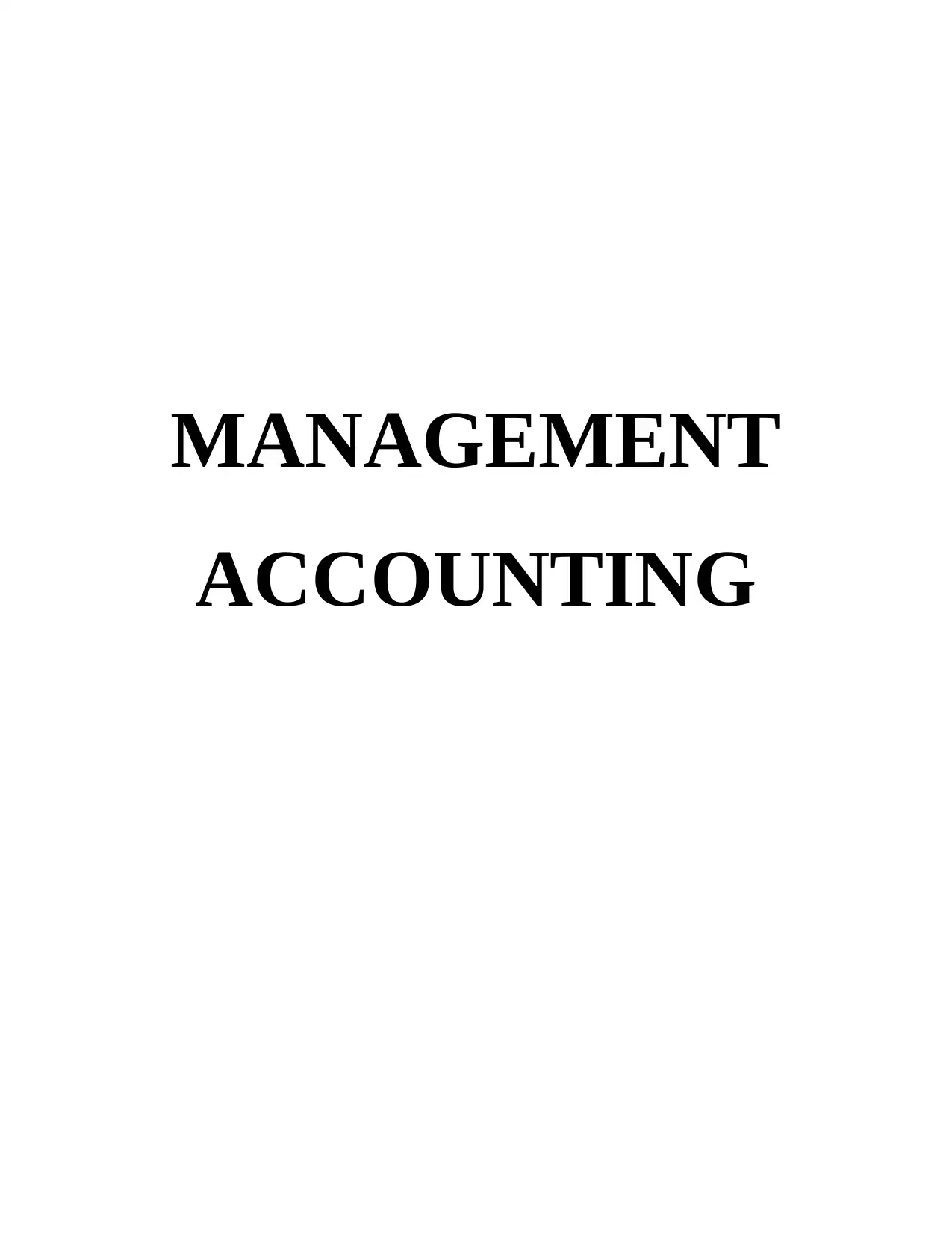
MANAGEMENT
ACCOUNTING
ACCOUNTING
Secure Best Marks with AI Grader
Need help grading? Try our AI Grader for instant feedback on your assignments.
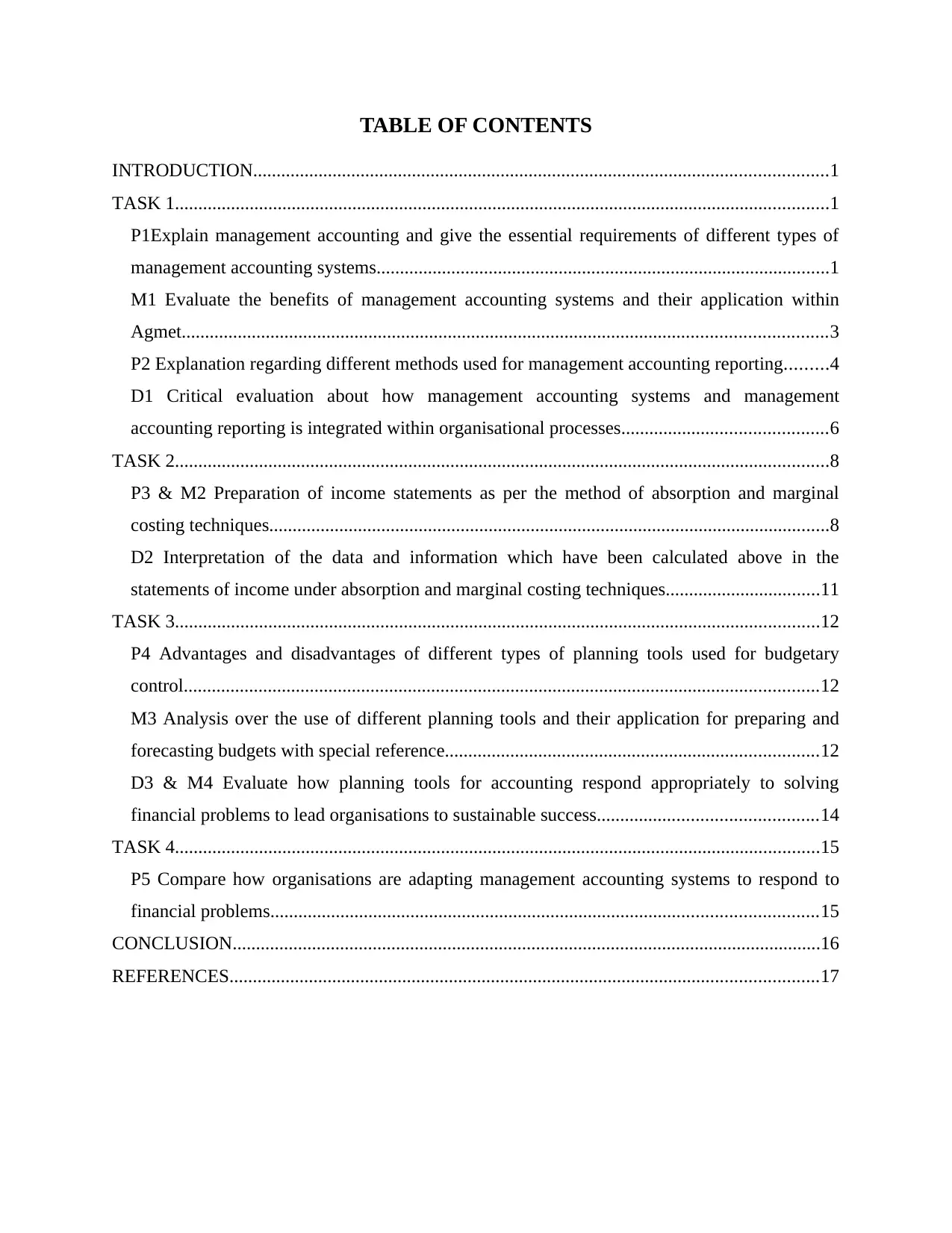
TABLE OF CONTENTS
INTRODUCTION...........................................................................................................................1
TASK 1............................................................................................................................................1
P1Explain management accounting and give the essential requirements of different types of
management accounting systems.................................................................................................1
M1 Evaluate the benefits of management accounting systems and their application within
Agmet..........................................................................................................................................3
P2 Explanation regarding different methods used for management accounting reporting.........4
D1 Critical evaluation about how management accounting systems and management
accounting reporting is integrated within organisational processes............................................6
TASK 2............................................................................................................................................8
P3 & M2 Preparation of income statements as per the method of absorption and marginal
costing techniques........................................................................................................................8
D2 Interpretation of the data and information which have been calculated above in the
statements of income under absorption and marginal costing techniques.................................11
TASK 3..........................................................................................................................................12
P4 Advantages and disadvantages of different types of planning tools used for budgetary
control........................................................................................................................................12
M3 Analysis over the use of different planning tools and their application for preparing and
forecasting budgets with special reference................................................................................12
D3 & M4 Evaluate how planning tools for accounting respond appropriately to solving
financial problems to lead organisations to sustainable success...............................................14
TASK 4..........................................................................................................................................15
P5 Compare how organisations are adapting management accounting systems to respond to
financial problems.....................................................................................................................15
CONCLUSION..............................................................................................................................16
REFERENCES..............................................................................................................................17
INTRODUCTION...........................................................................................................................1
TASK 1............................................................................................................................................1
P1Explain management accounting and give the essential requirements of different types of
management accounting systems.................................................................................................1
M1 Evaluate the benefits of management accounting systems and their application within
Agmet..........................................................................................................................................3
P2 Explanation regarding different methods used for management accounting reporting.........4
D1 Critical evaluation about how management accounting systems and management
accounting reporting is integrated within organisational processes............................................6
TASK 2............................................................................................................................................8
P3 & M2 Preparation of income statements as per the method of absorption and marginal
costing techniques........................................................................................................................8
D2 Interpretation of the data and information which have been calculated above in the
statements of income under absorption and marginal costing techniques.................................11
TASK 3..........................................................................................................................................12
P4 Advantages and disadvantages of different types of planning tools used for budgetary
control........................................................................................................................................12
M3 Analysis over the use of different planning tools and their application for preparing and
forecasting budgets with special reference................................................................................12
D3 & M4 Evaluate how planning tools for accounting respond appropriately to solving
financial problems to lead organisations to sustainable success...............................................14
TASK 4..........................................................................................................................................15
P5 Compare how organisations are adapting management accounting systems to respond to
financial problems.....................................................................................................................15
CONCLUSION..............................................................................................................................16
REFERENCES..............................................................................................................................17

INTRODUCTION
Management accounting can be considered as a technique though which management of
any enterprise can easily manage their available resources(Renz, 2016). As a small business
enterprise Agmet is having less resources whether in terms of financial or in terms of non
financial sources. Hence it is important for such enterprise to manage their sources for attaining
the objectives of the enterprise which are predetermined by its managerial personnel’s including
top level management. This report has been framed on the case study of Agmet which is a
chemical manufacturing company in United Kingdom (Gibassier, 2017). Its employing less than
50 employees and they are having less £500,000 hence it can be said that they need to employ
techniques of cost and management accounting in its financial and organisational structure. In
this report the concept of cost accounting have been defined with their essential requirements.
Further there are two statements as per the method of absorption and marginal costing and such
statements are presented with there interpretation.
TASK 1
P1Explain management accounting and give the essential requirements of different types of
management accounting systems
Management accounting can be referred as the combination of both financial accounting
concepts and managerial principles. Hence it can be said that Agmet and its management through
optimizing the principles which are there in cost accounting can achieve the goals and objectives
which are there in the organisational structure since from beginning and the short term goals
which are there in current period. As short term goals can only contribute towards the managing
the long term goals and objectives (Quinn, 2011). There are many essential requirements of
management accounting as same as financial accounting hence it can be said that just like
financial reporting frameworks management accounting is also having certain requirements
which needs to be fulfilled so that the users can get the clear image of the company so that they
can make their decisions in respect of it. It have the combination of principles and data which
makes it reliable and the plans which are framed according to it are also ethical and achievable.
Because of it the managers and employees will not get frustrated in achieving the targets which
are determined by the top level management. Agmet can abolish the competitive factors out of
the chemical manufacturing market (Ibarrondo-Dávila, López-Alonso and Rubio-Gámez, 2015).
1
Management accounting can be considered as a technique though which management of
any enterprise can easily manage their available resources(Renz, 2016). As a small business
enterprise Agmet is having less resources whether in terms of financial or in terms of non
financial sources. Hence it is important for such enterprise to manage their sources for attaining
the objectives of the enterprise which are predetermined by its managerial personnel’s including
top level management. This report has been framed on the case study of Agmet which is a
chemical manufacturing company in United Kingdom (Gibassier, 2017). Its employing less than
50 employees and they are having less £500,000 hence it can be said that they need to employ
techniques of cost and management accounting in its financial and organisational structure. In
this report the concept of cost accounting have been defined with their essential requirements.
Further there are two statements as per the method of absorption and marginal costing and such
statements are presented with there interpretation.
TASK 1
P1Explain management accounting and give the essential requirements of different types of
management accounting systems
Management accounting can be referred as the combination of both financial accounting
concepts and managerial principles. Hence it can be said that Agmet and its management through
optimizing the principles which are there in cost accounting can achieve the goals and objectives
which are there in the organisational structure since from beginning and the short term goals
which are there in current period. As short term goals can only contribute towards the managing
the long term goals and objectives (Quinn, 2011). There are many essential requirements of
management accounting as same as financial accounting hence it can be said that just like
financial reporting frameworks management accounting is also having certain requirements
which needs to be fulfilled so that the users can get the clear image of the company so that they
can make their decisions in respect of it. It have the combination of principles and data which
makes it reliable and the plans which are framed according to it are also ethical and achievable.
Because of it the managers and employees will not get frustrated in achieving the targets which
are determined by the top level management. Agmet can abolish the competitive factors out of
the chemical manufacturing market (Ibarrondo-Dávila, López-Alonso and Rubio-Gámez, 2015).
1
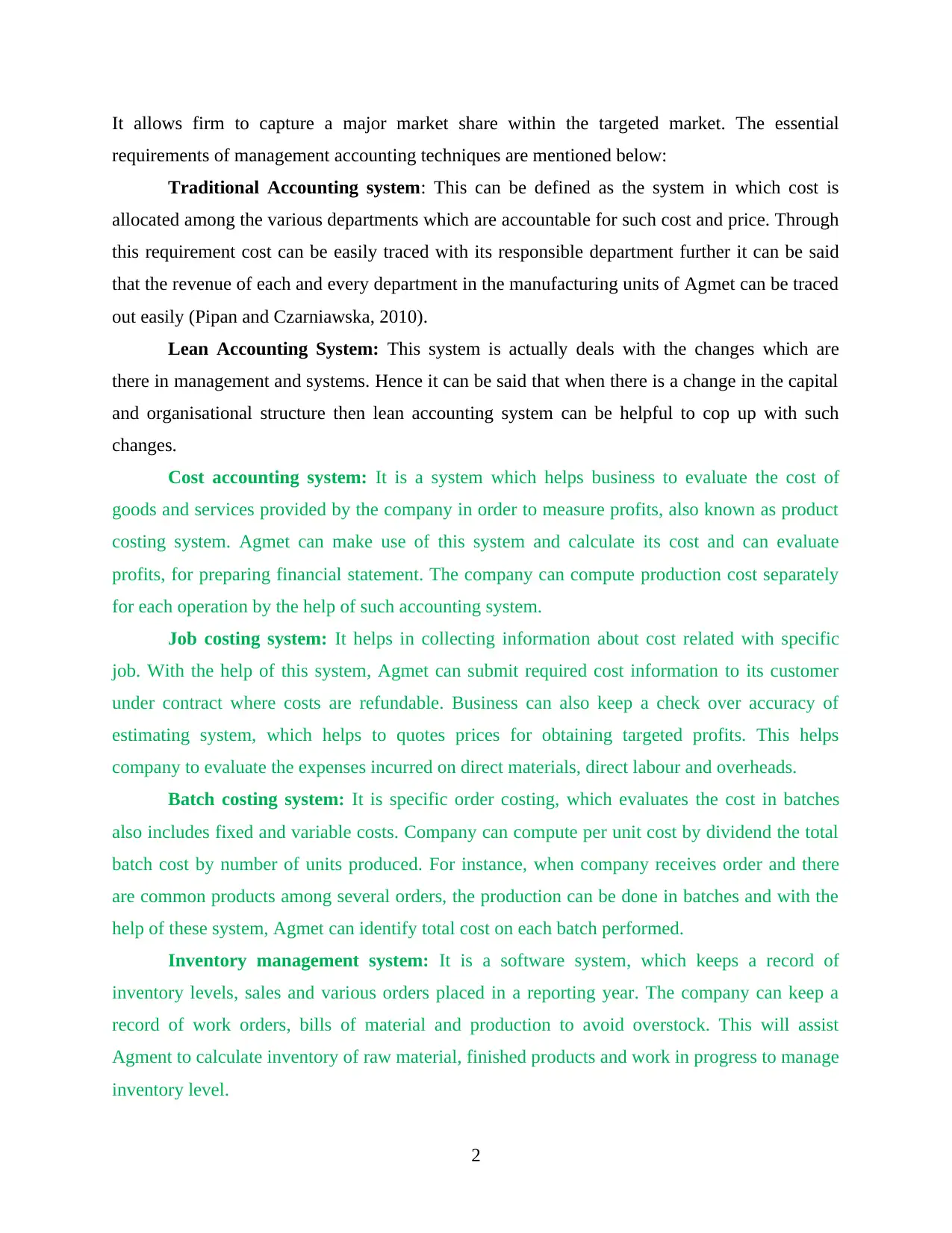
It allows firm to capture a major market share within the targeted market. The essential
requirements of management accounting techniques are mentioned below:
Traditional Accounting system: This can be defined as the system in which cost is
allocated among the various departments which are accountable for such cost and price. Through
this requirement cost can be easily traced with its responsible department further it can be said
that the revenue of each and every department in the manufacturing units of Agmet can be traced
out easily (Pipan and Czarniawska, 2010).
Lean Accounting System: This system is actually deals with the changes which are
there in management and systems. Hence it can be said that when there is a change in the capital
and organisational structure then lean accounting system can be helpful to cop up with such
changes.
Cost accounting system: It is a system which helps business to evaluate the cost of
goods and services provided by the company in order to measure profits, also known as product
costing system. Agmet can make use of this system and calculate its cost and can evaluate
profits, for preparing financial statement. The company can compute production cost separately
for each operation by the help of such accounting system.
Job costing system: It helps in collecting information about cost related with specific
job. With the help of this system, Agmet can submit required cost information to its customer
under contract where costs are refundable. Business can also keep a check over accuracy of
estimating system, which helps to quotes prices for obtaining targeted profits. This helps
company to evaluate the expenses incurred on direct materials, direct labour and overheads.
Batch costing system: It is specific order costing, which evaluates the cost in batches
also includes fixed and variable costs. Company can compute per unit cost by dividend the total
batch cost by number of units produced. For instance, when company receives order and there
are common products among several orders, the production can be done in batches and with the
help of these system, Agmet can identify total cost on each batch performed.
Inventory management system: It is a software system, which keeps a record of
inventory levels, sales and various orders placed in a reporting year. The company can keep a
record of work orders, bills of material and production to avoid overstock. This will assist
Agment to calculate inventory of raw material, finished products and work in progress to manage
inventory level.
2
requirements of management accounting techniques are mentioned below:
Traditional Accounting system: This can be defined as the system in which cost is
allocated among the various departments which are accountable for such cost and price. Through
this requirement cost can be easily traced with its responsible department further it can be said
that the revenue of each and every department in the manufacturing units of Agmet can be traced
out easily (Pipan and Czarniawska, 2010).
Lean Accounting System: This system is actually deals with the changes which are
there in management and systems. Hence it can be said that when there is a change in the capital
and organisational structure then lean accounting system can be helpful to cop up with such
changes.
Cost accounting system: It is a system which helps business to evaluate the cost of
goods and services provided by the company in order to measure profits, also known as product
costing system. Agmet can make use of this system and calculate its cost and can evaluate
profits, for preparing financial statement. The company can compute production cost separately
for each operation by the help of such accounting system.
Job costing system: It helps in collecting information about cost related with specific
job. With the help of this system, Agmet can submit required cost information to its customer
under contract where costs are refundable. Business can also keep a check over accuracy of
estimating system, which helps to quotes prices for obtaining targeted profits. This helps
company to evaluate the expenses incurred on direct materials, direct labour and overheads.
Batch costing system: It is specific order costing, which evaluates the cost in batches
also includes fixed and variable costs. Company can compute per unit cost by dividend the total
batch cost by number of units produced. For instance, when company receives order and there
are common products among several orders, the production can be done in batches and with the
help of these system, Agmet can identify total cost on each batch performed.
Inventory management system: It is a software system, which keeps a record of
inventory levels, sales and various orders placed in a reporting year. The company can keep a
record of work orders, bills of material and production to avoid overstock. This will assist
Agment to calculate inventory of raw material, finished products and work in progress to manage
inventory level.
2
Secure Best Marks with AI Grader
Need help grading? Try our AI Grader for instant feedback on your assignments.
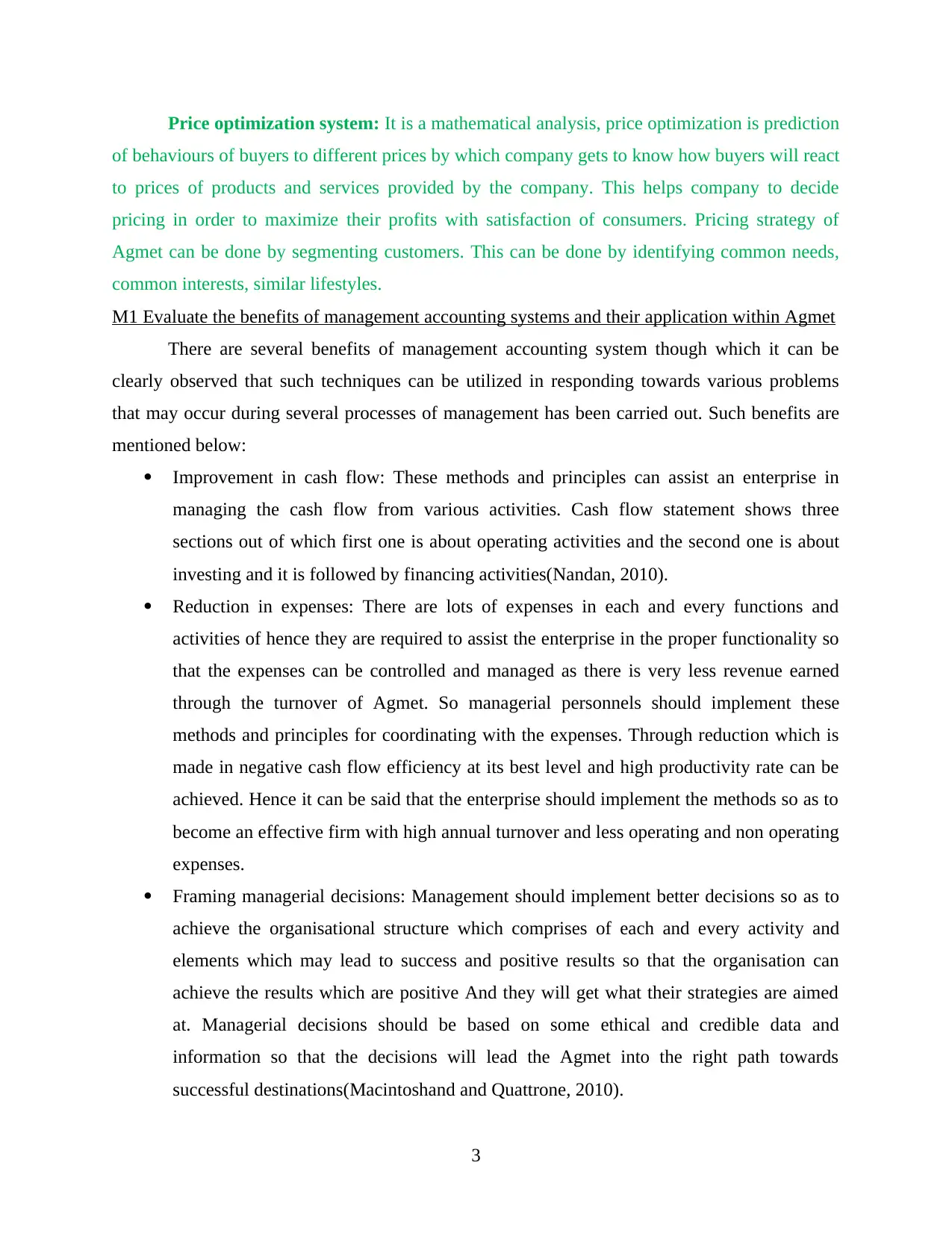
Price optimization system: It is a mathematical analysis, price optimization is prediction
of behaviours of buyers to different prices by which company gets to know how buyers will react
to prices of products and services provided by the company. This helps company to decide
pricing in order to maximize their profits with satisfaction of consumers. Pricing strategy of
Agmet can be done by segmenting customers. This can be done by identifying common needs,
common interests, similar lifestyles.
M1 Evaluate the benefits of management accounting systems and their application within Agmet
There are several benefits of management accounting system though which it can be
clearly observed that such techniques can be utilized in responding towards various problems
that may occur during several processes of management has been carried out. Such benefits are
mentioned below:
Improvement in cash flow: These methods and principles can assist an enterprise in
managing the cash flow from various activities. Cash flow statement shows three
sections out of which first one is about operating activities and the second one is about
investing and it is followed by financing activities(Nandan, 2010).
Reduction in expenses: There are lots of expenses in each and every functions and
activities of hence they are required to assist the enterprise in the proper functionality so
that the expenses can be controlled and managed as there is very less revenue earned
through the turnover of Agmet. So managerial personnels should implement these
methods and principles for coordinating with the expenses. Through reduction which is
made in negative cash flow efficiency at its best level and high productivity rate can be
achieved. Hence it can be said that the enterprise should implement the methods so as to
become an effective firm with high annual turnover and less operating and non operating
expenses.
Framing managerial decisions: Management should implement better decisions so as to
achieve the organisational structure which comprises of each and every activity and
elements which may lead to success and positive results so that the organisation can
achieve the results which are positive And they will get what their strategies are aimed
at. Managerial decisions should be based on some ethical and credible data and
information so that the decisions will lead the Agmet into the right path towards
successful destinations(Macintoshand and Quattrone, 2010).
3
of behaviours of buyers to different prices by which company gets to know how buyers will react
to prices of products and services provided by the company. This helps company to decide
pricing in order to maximize their profits with satisfaction of consumers. Pricing strategy of
Agmet can be done by segmenting customers. This can be done by identifying common needs,
common interests, similar lifestyles.
M1 Evaluate the benefits of management accounting systems and their application within Agmet
There are several benefits of management accounting system though which it can be
clearly observed that such techniques can be utilized in responding towards various problems
that may occur during several processes of management has been carried out. Such benefits are
mentioned below:
Improvement in cash flow: These methods and principles can assist an enterprise in
managing the cash flow from various activities. Cash flow statement shows three
sections out of which first one is about operating activities and the second one is about
investing and it is followed by financing activities(Nandan, 2010).
Reduction in expenses: There are lots of expenses in each and every functions and
activities of hence they are required to assist the enterprise in the proper functionality so
that the expenses can be controlled and managed as there is very less revenue earned
through the turnover of Agmet. So managerial personnels should implement these
methods and principles for coordinating with the expenses. Through reduction which is
made in negative cash flow efficiency at its best level and high productivity rate can be
achieved. Hence it can be said that the enterprise should implement the methods so as to
become an effective firm with high annual turnover and less operating and non operating
expenses.
Framing managerial decisions: Management should implement better decisions so as to
achieve the organisational structure which comprises of each and every activity and
elements which may lead to success and positive results so that the organisation can
achieve the results which are positive And they will get what their strategies are aimed
at. Managerial decisions should be based on some ethical and credible data and
information so that the decisions will lead the Agmet into the right path towards
successful destinations(Macintoshand and Quattrone, 2010).
3

Financial Planning : through implementation of the techniques and methods of financial
and cost accounting, management can introduce better cost structure which can be
considered as the optimum capital composition. In optimum capital structure the
financial resources are having less obligations but they are capable enough to generate
high returns in accordance with the plans and strategies which were previously
determined by the top level management of the cited firm.
P2 Explanation regarding different methods used for management accounting reporting
There are several methods which can be used by the cited enterprise for the management
of business affairs and to get the right return which have been estimated and observed by the top
level management of Agmet. Finally it can be said that the different methods which are used for
the financial reporting can help the management and other team who are responsible and
accountable for the preparation of the financial statements. As these methods presents the results
which are more credible and reliable hence they can predict the future image of enterprise and it
is the basic objective of financial reporting and its framework. There are several methods of
financial paling and reporting and these methods are mentioned below in detail with their
detailed features.
Job cost report: It is used to evaluate incur cost of organization from particular jobs. It
also compares actual cost and estimated cost in order to show profit margins. Agmet’s
manager can maintain these reports to avoid waste of resources and allocating resources.
It also helps to keep an eye on sales recovery, work in progress, value added and profit
summary.
Sales reports: A data maintained of calls made and sale of products and services during
specific period of time by manager or sales person. Daily check over sales cycle is a long
and complicated process that is why Agmet's sales manager can maintain sales report to
keep a track of customers interested, success rate, campaigning and closing rate.
Accounts receivable reports (AR): It is account receivable aging, data that file unpaid
customer invoices and unused credit memos according to dates. The company can use
this as an indicator to determine financial health of its customers. With the help of AR,
manager can maintain a snap shot of outstanding money due from the consumer and
create right credit extending decisions.
4
and cost accounting, management can introduce better cost structure which can be
considered as the optimum capital composition. In optimum capital structure the
financial resources are having less obligations but they are capable enough to generate
high returns in accordance with the plans and strategies which were previously
determined by the top level management of the cited firm.
P2 Explanation regarding different methods used for management accounting reporting
There are several methods which can be used by the cited enterprise for the management
of business affairs and to get the right return which have been estimated and observed by the top
level management of Agmet. Finally it can be said that the different methods which are used for
the financial reporting can help the management and other team who are responsible and
accountable for the preparation of the financial statements. As these methods presents the results
which are more credible and reliable hence they can predict the future image of enterprise and it
is the basic objective of financial reporting and its framework. There are several methods of
financial paling and reporting and these methods are mentioned below in detail with their
detailed features.
Job cost report: It is used to evaluate incur cost of organization from particular jobs. It
also compares actual cost and estimated cost in order to show profit margins. Agmet’s
manager can maintain these reports to avoid waste of resources and allocating resources.
It also helps to keep an eye on sales recovery, work in progress, value added and profit
summary.
Sales reports: A data maintained of calls made and sale of products and services during
specific period of time by manager or sales person. Daily check over sales cycle is a long
and complicated process that is why Agmet's sales manager can maintain sales report to
keep a track of customers interested, success rate, campaigning and closing rate.
Accounts receivable reports (AR): It is account receivable aging, data that file unpaid
customer invoices and unused credit memos according to dates. The company can use
this as an indicator to determine financial health of its customers. With the help of AR,
manager can maintain a snap shot of outstanding money due from the consumer and
create right credit extending decisions.
4

Inventory management reports: It is a synopsis of items belonging to an organization
inclusive account of stock and supply. Manager should maintain inventory reports in
order to improve productivity in store and also enables Agmet to improve efficiency of
ordering and delivery through proper inventory management.
Ratio Analysis: ratio analysis can be presented as the techniques which in fact consist of
ratios and other calculative tasks(Lukkaand and Modell, 2010). These calculations and
task are scientific and universally accepted hence it can be said that through using the
ratio analysis the management can lead to organisational benefits and they can frame
better strategies and reporting framework through optimizing the profitability, efficiency
and turnover ratios. As through it they can easily estimate that whether they are capable
enough to pay off the debts of the enterprise so that goodwill of Agmet in chemical
market can be maintained.
Fund Flow Analysis: This analysis is done on a statement which contain the working over
the working capital and it also consists of the tools through which the sources and
application of funds can be targeted and calculated easily so that the managerial
personnels can control over the different areas in which the sources have been utilized.
So far as the matter of sources from where the finance and funding is acquired then it can
said that better steps can be taken by the top managerial and middle level managerial
personnels for acquiring the finance as well as they can get better sources through which
they can acquire the funds(Luftand and Shields, 2010).
Cash flow analysis: Cash flow analysis and its controls can be applied in the top
managerial activities as through it they can manage the cash inflow and cash out flow. As
the cash flow statement consists of three sections hence it can be said that there are three
segments through which the managerial personnel’s can observe that how much fund or
cash is utilized in which activity. Further they can observe that how much cash is in
category of inflow and how much is in the category of outflow (Kihn and Ihantola, 2015).
Operating activities and its cash flow can assist them to make strategies and decisions
regarding the operational activities and through investing activities they can find out the
total cash used or generated through investing activities. Further the third section of cash
flow is all about the financing activity so the cash flow which is generated from the
activities of finance can lead to take decisions in reference of financial planning. Hence
5
inclusive account of stock and supply. Manager should maintain inventory reports in
order to improve productivity in store and also enables Agmet to improve efficiency of
ordering and delivery through proper inventory management.
Ratio Analysis: ratio analysis can be presented as the techniques which in fact consist of
ratios and other calculative tasks(Lukkaand and Modell, 2010). These calculations and
task are scientific and universally accepted hence it can be said that through using the
ratio analysis the management can lead to organisational benefits and they can frame
better strategies and reporting framework through optimizing the profitability, efficiency
and turnover ratios. As through it they can easily estimate that whether they are capable
enough to pay off the debts of the enterprise so that goodwill of Agmet in chemical
market can be maintained.
Fund Flow Analysis: This analysis is done on a statement which contain the working over
the working capital and it also consists of the tools through which the sources and
application of funds can be targeted and calculated easily so that the managerial
personnels can control over the different areas in which the sources have been utilized.
So far as the matter of sources from where the finance and funding is acquired then it can
said that better steps can be taken by the top managerial and middle level managerial
personnels for acquiring the finance as well as they can get better sources through which
they can acquire the funds(Luftand and Shields, 2010).
Cash flow analysis: Cash flow analysis and its controls can be applied in the top
managerial activities as through it they can manage the cash inflow and cash out flow. As
the cash flow statement consists of three sections hence it can be said that there are three
segments through which the managerial personnel’s can observe that how much fund or
cash is utilized in which activity. Further they can observe that how much cash is in
category of inflow and how much is in the category of outflow (Kihn and Ihantola, 2015).
Operating activities and its cash flow can assist them to make strategies and decisions
regarding the operational activities and through investing activities they can find out the
total cash used or generated through investing activities. Further the third section of cash
flow is all about the financing activity so the cash flow which is generated from the
activities of finance can lead to take decisions in reference of financial planning. Hence
5
Paraphrase This Document
Need a fresh take? Get an instant paraphrase of this document with our AI Paraphraser
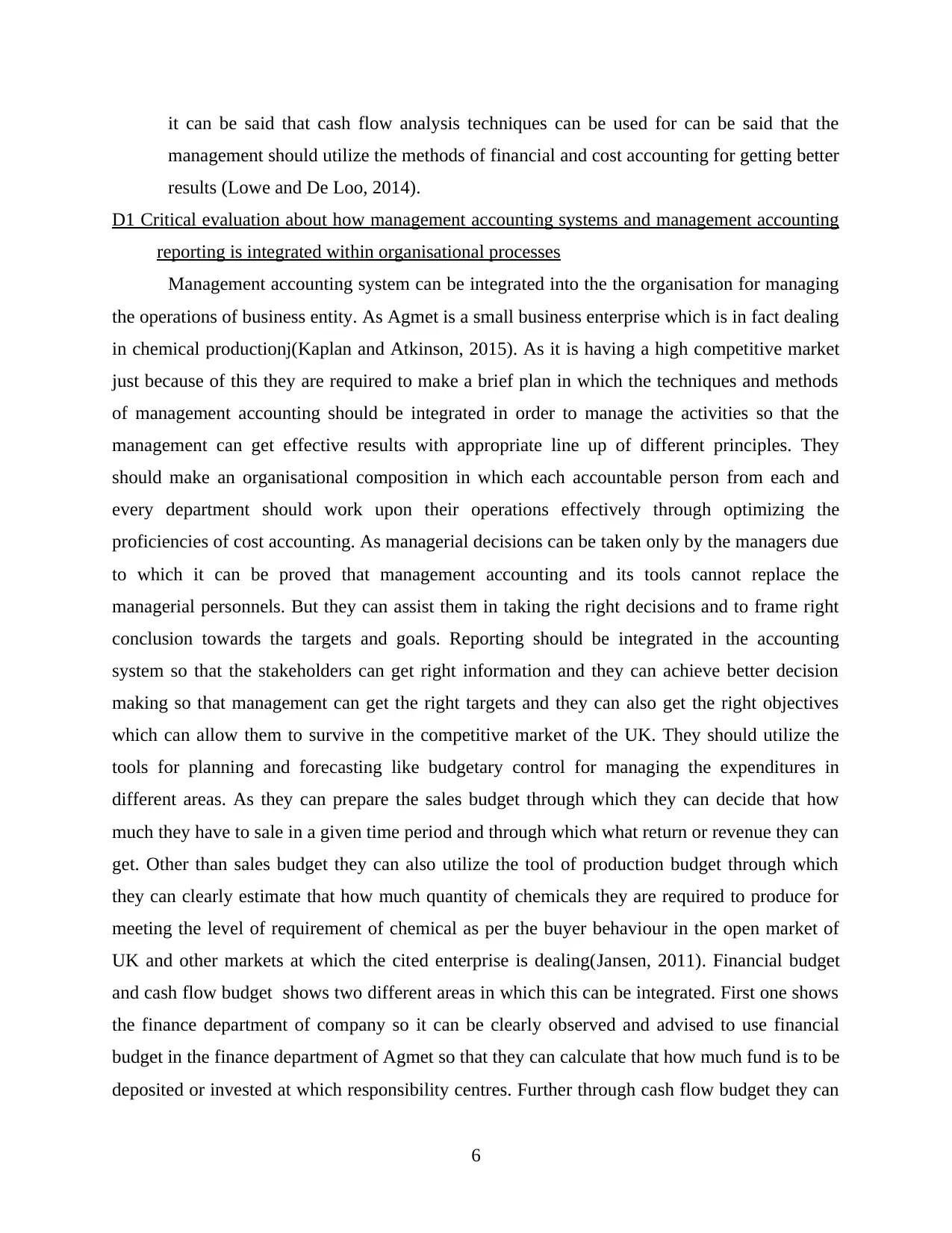
it can be said that cash flow analysis techniques can be used for can be said that the
management should utilize the methods of financial and cost accounting for getting better
results (Lowe and De Loo, 2014).
D1 Critical evaluation about how management accounting systems and management accounting
reporting is integrated within organisational processes
Management accounting system can be integrated into the the organisation for managing
the operations of business entity. As Agmet is a small business enterprise which is in fact dealing
in chemical productionj(Kaplan and Atkinson, 2015). As it is having a high competitive market
just because of this they are required to make a brief plan in which the techniques and methods
of management accounting should be integrated in order to manage the activities so that the
management can get effective results with appropriate line up of different principles. They
should make an organisational composition in which each accountable person from each and
every department should work upon their operations effectively through optimizing the
proficiencies of cost accounting. As managerial decisions can be taken only by the managers due
to which it can be proved that management accounting and its tools cannot replace the
managerial personnels. But they can assist them in taking the right decisions and to frame right
conclusion towards the targets and goals. Reporting should be integrated in the accounting
system so that the stakeholders can get right information and they can achieve better decision
making so that management can get the right targets and they can also get the right objectives
which can allow them to survive in the competitive market of the UK. They should utilize the
tools for planning and forecasting like budgetary control for managing the expenditures in
different areas. As they can prepare the sales budget through which they can decide that how
much they have to sale in a given time period and through which what return or revenue they can
get. Other than sales budget they can also utilize the tool of production budget through which
they can clearly estimate that how much quantity of chemicals they are required to produce for
meeting the level of requirement of chemical as per the buyer behaviour in the open market of
UK and other markets at which the cited enterprise is dealing(Jansen, 2011). Financial budget
and cash flow budget shows two different areas in which this can be integrated. First one shows
the finance department of company so it can be clearly observed and advised to use financial
budget in the finance department of Agmet so that they can calculate that how much fund is to be
deposited or invested at which responsibility centres. Further through cash flow budget they can
6
management should utilize the methods of financial and cost accounting for getting better
results (Lowe and De Loo, 2014).
D1 Critical evaluation about how management accounting systems and management accounting
reporting is integrated within organisational processes
Management accounting system can be integrated into the the organisation for managing
the operations of business entity. As Agmet is a small business enterprise which is in fact dealing
in chemical productionj(Kaplan and Atkinson, 2015). As it is having a high competitive market
just because of this they are required to make a brief plan in which the techniques and methods
of management accounting should be integrated in order to manage the activities so that the
management can get effective results with appropriate line up of different principles. They
should make an organisational composition in which each accountable person from each and
every department should work upon their operations effectively through optimizing the
proficiencies of cost accounting. As managerial decisions can be taken only by the managers due
to which it can be proved that management accounting and its tools cannot replace the
managerial personnels. But they can assist them in taking the right decisions and to frame right
conclusion towards the targets and goals. Reporting should be integrated in the accounting
system so that the stakeholders can get right information and they can achieve better decision
making so that management can get the right targets and they can also get the right objectives
which can allow them to survive in the competitive market of the UK. They should utilize the
tools for planning and forecasting like budgetary control for managing the expenditures in
different areas. As they can prepare the sales budget through which they can decide that how
much they have to sale in a given time period and through which what return or revenue they can
get. Other than sales budget they can also utilize the tool of production budget through which
they can clearly estimate that how much quantity of chemicals they are required to produce for
meeting the level of requirement of chemical as per the buyer behaviour in the open market of
UK and other markets at which the cited enterprise is dealing(Jansen, 2011). Financial budget
and cash flow budget shows two different areas in which this can be integrated. First one shows
the finance department of company so it can be clearly observed and advised to use financial
budget in the finance department of Agmet so that they can calculate that how much fund is to be
deposited or invested at which responsibility centres. Further through cash flow budget they can
6
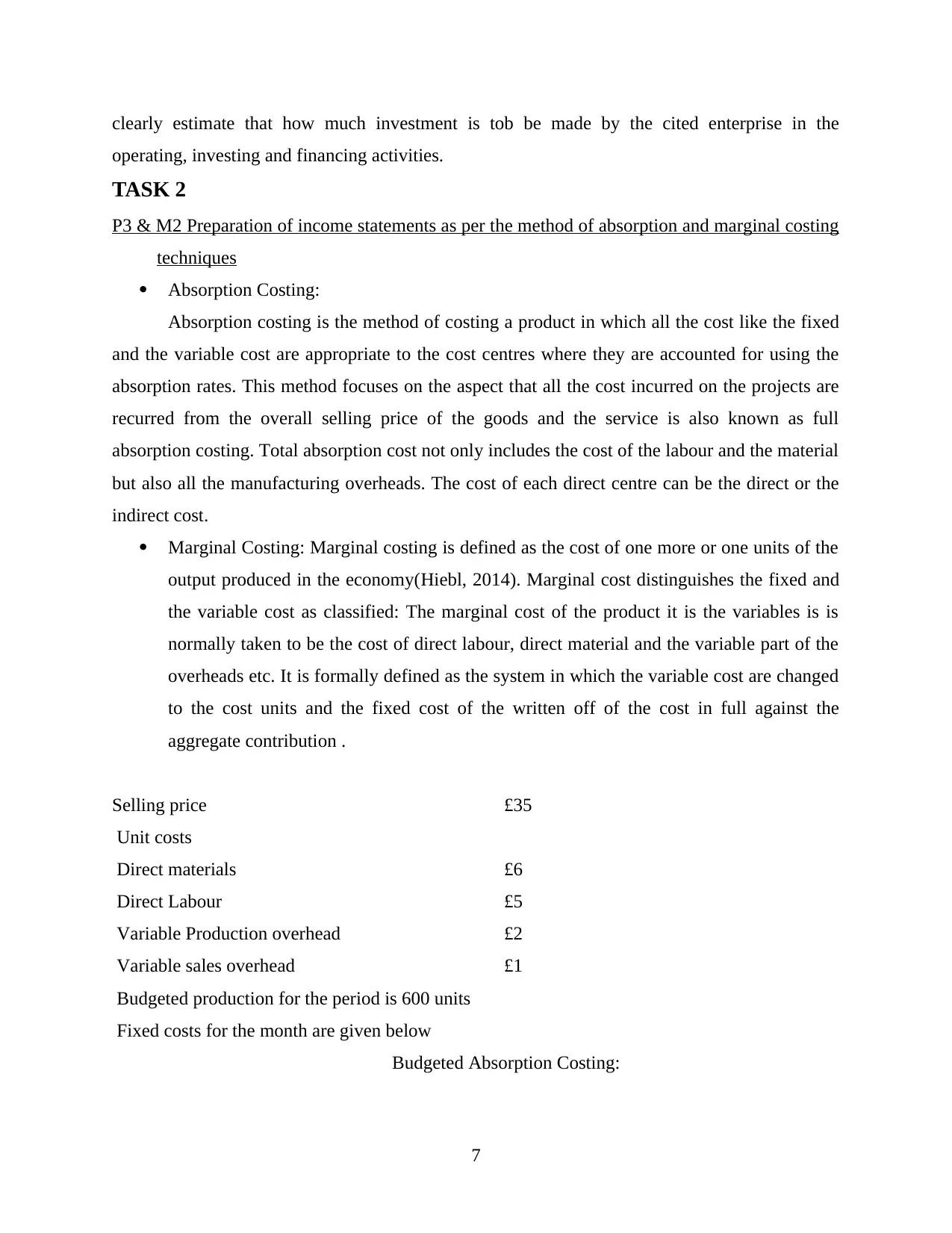
clearly estimate that how much investment is tob be made by the cited enterprise in the
operating, investing and financing activities.
TASK 2
P3 & M2 Preparation of income statements as per the method of absorption and marginal costing
techniques
Absorption Costing:
Absorption costing is the method of costing a product in which all the cost like the fixed
and the variable cost are appropriate to the cost centres where they are accounted for using the
absorption rates. This method focuses on the aspect that all the cost incurred on the projects are
recurred from the overall selling price of the goods and the service is also known as full
absorption costing. Total absorption cost not only includes the cost of the labour and the material
but also all the manufacturing overheads. The cost of each direct centre can be the direct or the
indirect cost.
Marginal Costing: Marginal costing is defined as the cost of one more or one units of the
output produced in the economy(Hiebl, 2014). Marginal cost distinguishes the fixed and
the variable cost as classified: The marginal cost of the product it is the variables is is
normally taken to be the cost of direct labour, direct material and the variable part of the
overheads etc. It is formally defined as the system in which the variable cost are changed
to the cost units and the fixed cost of the written off of the cost in full against the
aggregate contribution .
Selling price £35
Unit costs
Direct materials £6
Direct Labour £5
Variable Production overhead £2
Variable sales overhead £1
Budgeted production for the period is 600 units
Fixed costs for the month are given below
Budgeted Absorption Costing:
7
operating, investing and financing activities.
TASK 2
P3 & M2 Preparation of income statements as per the method of absorption and marginal costing
techniques
Absorption Costing:
Absorption costing is the method of costing a product in which all the cost like the fixed
and the variable cost are appropriate to the cost centres where they are accounted for using the
absorption rates. This method focuses on the aspect that all the cost incurred on the projects are
recurred from the overall selling price of the goods and the service is also known as full
absorption costing. Total absorption cost not only includes the cost of the labour and the material
but also all the manufacturing overheads. The cost of each direct centre can be the direct or the
indirect cost.
Marginal Costing: Marginal costing is defined as the cost of one more or one units of the
output produced in the economy(Hiebl, 2014). Marginal cost distinguishes the fixed and
the variable cost as classified: The marginal cost of the product it is the variables is is
normally taken to be the cost of direct labour, direct material and the variable part of the
overheads etc. It is formally defined as the system in which the variable cost are changed
to the cost units and the fixed cost of the written off of the cost in full against the
aggregate contribution .
Selling price £35
Unit costs
Direct materials £6
Direct Labour £5
Variable Production overhead £2
Variable sales overhead £1
Budgeted production for the period is 600 units
Fixed costs for the month are given below
Budgeted Absorption Costing:
7
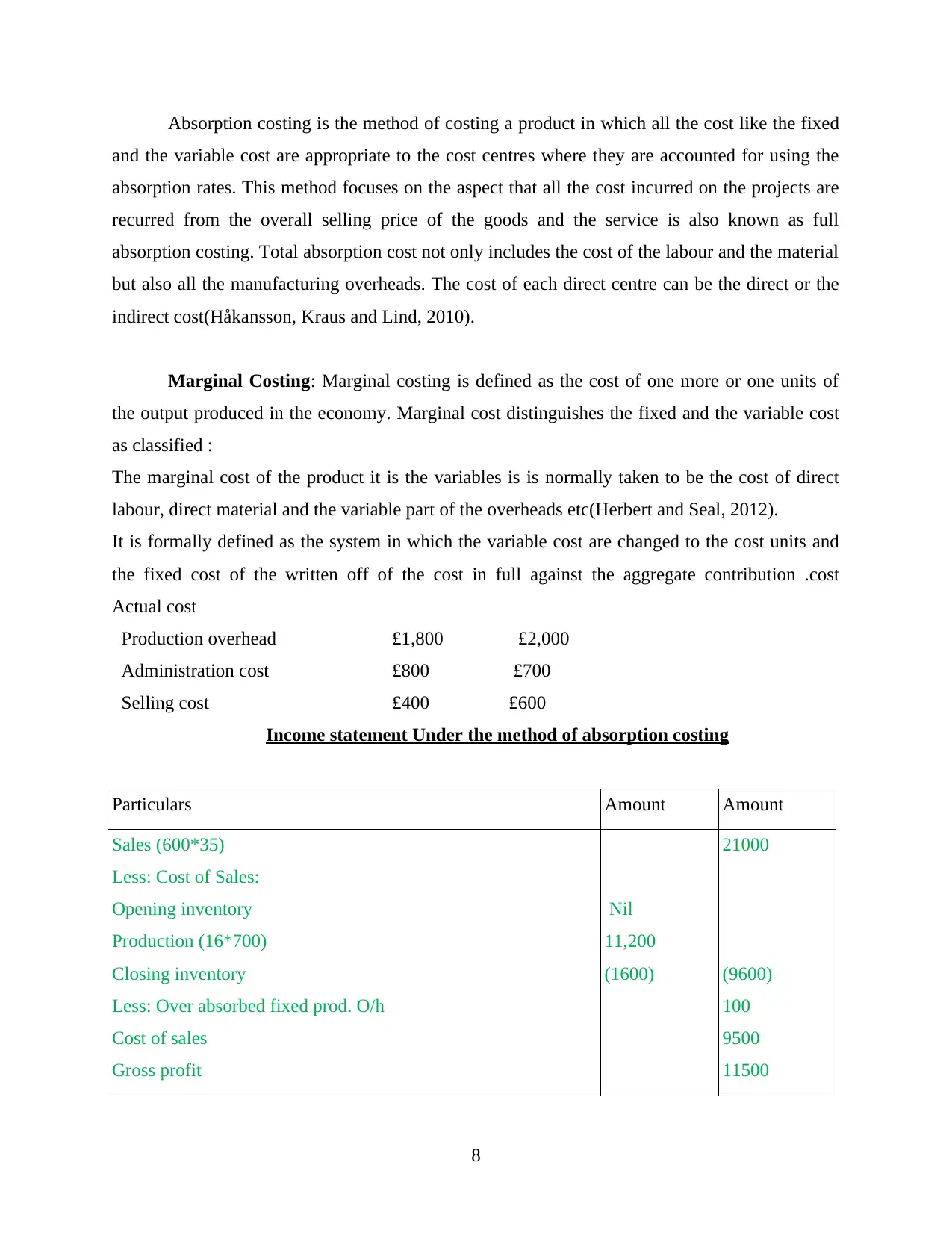
Absorption costing is the method of costing a product in which all the cost like the fixed
and the variable cost are appropriate to the cost centres where they are accounted for using the
absorption rates. This method focuses on the aspect that all the cost incurred on the projects are
recurred from the overall selling price of the goods and the service is also known as full
absorption costing. Total absorption cost not only includes the cost of the labour and the material
but also all the manufacturing overheads. The cost of each direct centre can be the direct or the
indirect cost(Håkansson, Kraus and Lind, 2010).
Marginal Costing: Marginal costing is defined as the cost of one more or one units of
the output produced in the economy. Marginal cost distinguishes the fixed and the variable cost
as classified :
The marginal cost of the product it is the variables is is normally taken to be the cost of direct
labour, direct material and the variable part of the overheads etc(Herbert and Seal, 2012).
It is formally defined as the system in which the variable cost are changed to the cost units and
the fixed cost of the written off of the cost in full against the aggregate contribution .cost
Actual cost
Production overhead £1,800 £2,000
Administration cost £800 £700
Selling cost £400 £600
Income statement Under the method of absorption costing
Particulars Amount Amount
Sales (600*35)
Less: Cost of Sales:
Opening inventory
Production (16*700)
Closing inventory
Less: Over absorbed fixed prod. O/h
Cost of sales
Gross profit
Nil
11,200
(1600)
21000
(9600)
100
9500
11500
8
and the variable cost are appropriate to the cost centres where they are accounted for using the
absorption rates. This method focuses on the aspect that all the cost incurred on the projects are
recurred from the overall selling price of the goods and the service is also known as full
absorption costing. Total absorption cost not only includes the cost of the labour and the material
but also all the manufacturing overheads. The cost of each direct centre can be the direct or the
indirect cost(Håkansson, Kraus and Lind, 2010).
Marginal Costing: Marginal costing is defined as the cost of one more or one units of
the output produced in the economy. Marginal cost distinguishes the fixed and the variable cost
as classified :
The marginal cost of the product it is the variables is is normally taken to be the cost of direct
labour, direct material and the variable part of the overheads etc(Herbert and Seal, 2012).
It is formally defined as the system in which the variable cost are changed to the cost units and
the fixed cost of the written off of the cost in full against the aggregate contribution .cost
Actual cost
Production overhead £1,800 £2,000
Administration cost £800 £700
Selling cost £400 £600
Income statement Under the method of absorption costing
Particulars Amount Amount
Sales (600*35)
Less: Cost of Sales:
Opening inventory
Production (16*700)
Closing inventory
Less: Over absorbed fixed prod. O/h
Cost of sales
Gross profit
Nil
11,200
(1600)
21000
(9600)
100
9500
11500
8
Secure Best Marks with AI Grader
Need help grading? Try our AI Grader for instant feedback on your assignments.
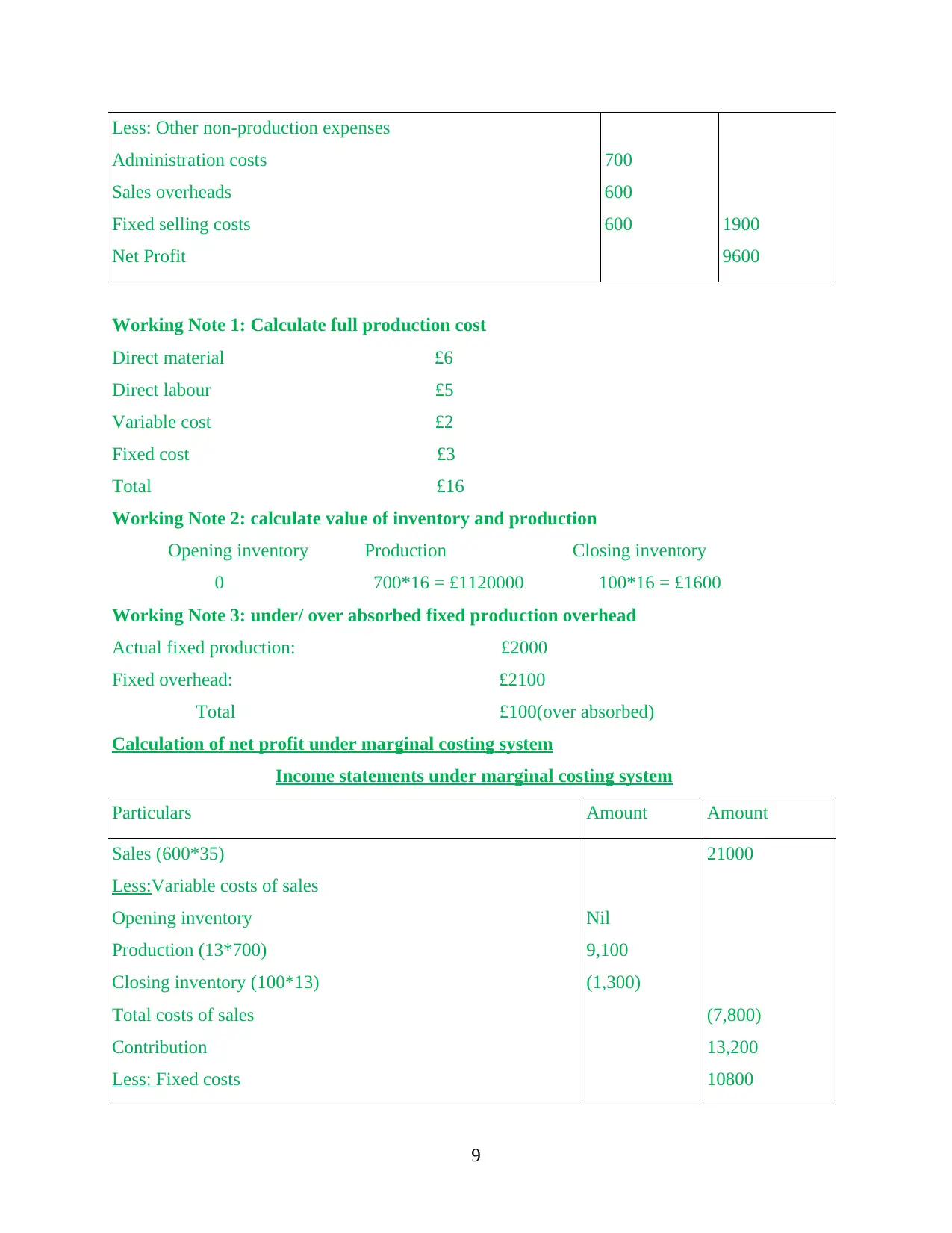
Less: Other non-production expenses
Administration costs
Sales overheads
Fixed selling costs
Net Profit
700
600
600 1900
9600
Working Note 1: Calculate full production cost
Direct material £6
Direct labour £5
Variable cost £2
Fixed cost £3
Total £16
Working Note 2: calculate value of inventory and production
Opening inventory Production Closing inventory
0 700*16 = £1120000 100*16 = £1600
Working Note 3: under/ over absorbed fixed production overhead
Actual fixed production: £2000
Fixed overhead: £2100
Total £100(over absorbed)
Calculation of net profit under marginal costing system
Income statements under marginal costing system
Particulars Amount Amount
Sales (600*35)
Less:Variable costs of sales
Opening inventory
Production (13*700)
Closing inventory (100*13)
Total costs of sales
Contribution
Less: Fixed costs
Nil
9,100
(1,300)
21000
(7,800)
13,200
10800
9
Administration costs
Sales overheads
Fixed selling costs
Net Profit
700
600
600 1900
9600
Working Note 1: Calculate full production cost
Direct material £6
Direct labour £5
Variable cost £2
Fixed cost £3
Total £16
Working Note 2: calculate value of inventory and production
Opening inventory Production Closing inventory
0 700*16 = £1120000 100*16 = £1600
Working Note 3: under/ over absorbed fixed production overhead
Actual fixed production: £2000
Fixed overhead: £2100
Total £100(over absorbed)
Calculation of net profit under marginal costing system
Income statements under marginal costing system
Particulars Amount Amount
Sales (600*35)
Less:Variable costs of sales
Opening inventory
Production (13*700)
Closing inventory (100*13)
Total costs of sales
Contribution
Less: Fixed costs
Nil
9,100
(1,300)
21000
(7,800)
13,200
10800
9
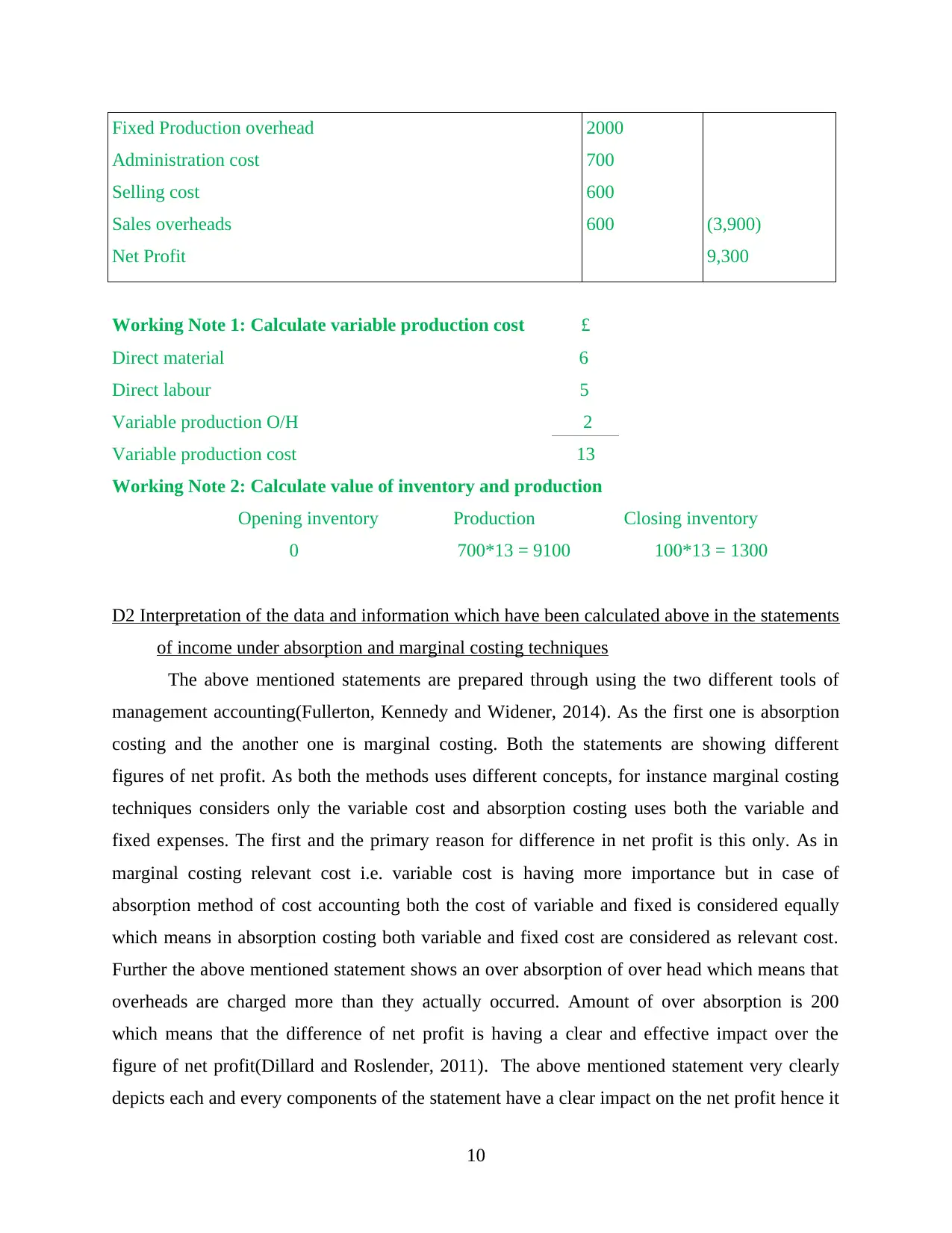
Fixed Production overhead
Administration cost
Selling cost
Sales overheads
Net Profit
2000
700
600
600 (3,900)
9,300
Working Note 1: Calculate variable production cost £
Direct material 6
Direct labour 5
Variable production O/H 2
Variable production cost 13
Working Note 2: Calculate value of inventory and production
Opening inventory Production Closing inventory
0 700*13 = 9100 100*13 = 1300
D2 Interpretation of the data and information which have been calculated above in the statements
of income under absorption and marginal costing techniques
The above mentioned statements are prepared through using the two different tools of
management accounting(Fullerton, Kennedy and Widener, 2014). As the first one is absorption
costing and the another one is marginal costing. Both the statements are showing different
figures of net profit. As both the methods uses different concepts, for instance marginal costing
techniques considers only the variable cost and absorption costing uses both the variable and
fixed expenses. The first and the primary reason for difference in net profit is this only. As in
marginal costing relevant cost i.e. variable cost is having more importance but in case of
absorption method of cost accounting both the cost of variable and fixed is considered equally
which means in absorption costing both variable and fixed cost are considered as relevant cost.
Further the above mentioned statement shows an over absorption of over head which means that
overheads are charged more than they actually occurred. Amount of over absorption is 200
which means that the difference of net profit is having a clear and effective impact over the
figure of net profit(Dillard and Roslender, 2011). The above mentioned statement very clearly
depicts each and every components of the statement have a clear impact on the net profit hence it
10
Administration cost
Selling cost
Sales overheads
Net Profit
2000
700
600
600 (3,900)
9,300
Working Note 1: Calculate variable production cost £
Direct material 6
Direct labour 5
Variable production O/H 2
Variable production cost 13
Working Note 2: Calculate value of inventory and production
Opening inventory Production Closing inventory
0 700*13 = 9100 100*13 = 1300
D2 Interpretation of the data and information which have been calculated above in the statements
of income under absorption and marginal costing techniques
The above mentioned statements are prepared through using the two different tools of
management accounting(Fullerton, Kennedy and Widener, 2014). As the first one is absorption
costing and the another one is marginal costing. Both the statements are showing different
figures of net profit. As both the methods uses different concepts, for instance marginal costing
techniques considers only the variable cost and absorption costing uses both the variable and
fixed expenses. The first and the primary reason for difference in net profit is this only. As in
marginal costing relevant cost i.e. variable cost is having more importance but in case of
absorption method of cost accounting both the cost of variable and fixed is considered equally
which means in absorption costing both variable and fixed cost are considered as relevant cost.
Further the above mentioned statement shows an over absorption of over head which means that
overheads are charged more than they actually occurred. Amount of over absorption is 200
which means that the difference of net profit is having a clear and effective impact over the
figure of net profit(Dillard and Roslender, 2011). The above mentioned statement very clearly
depicts each and every components of the statement have a clear impact on the net profit hence it
10
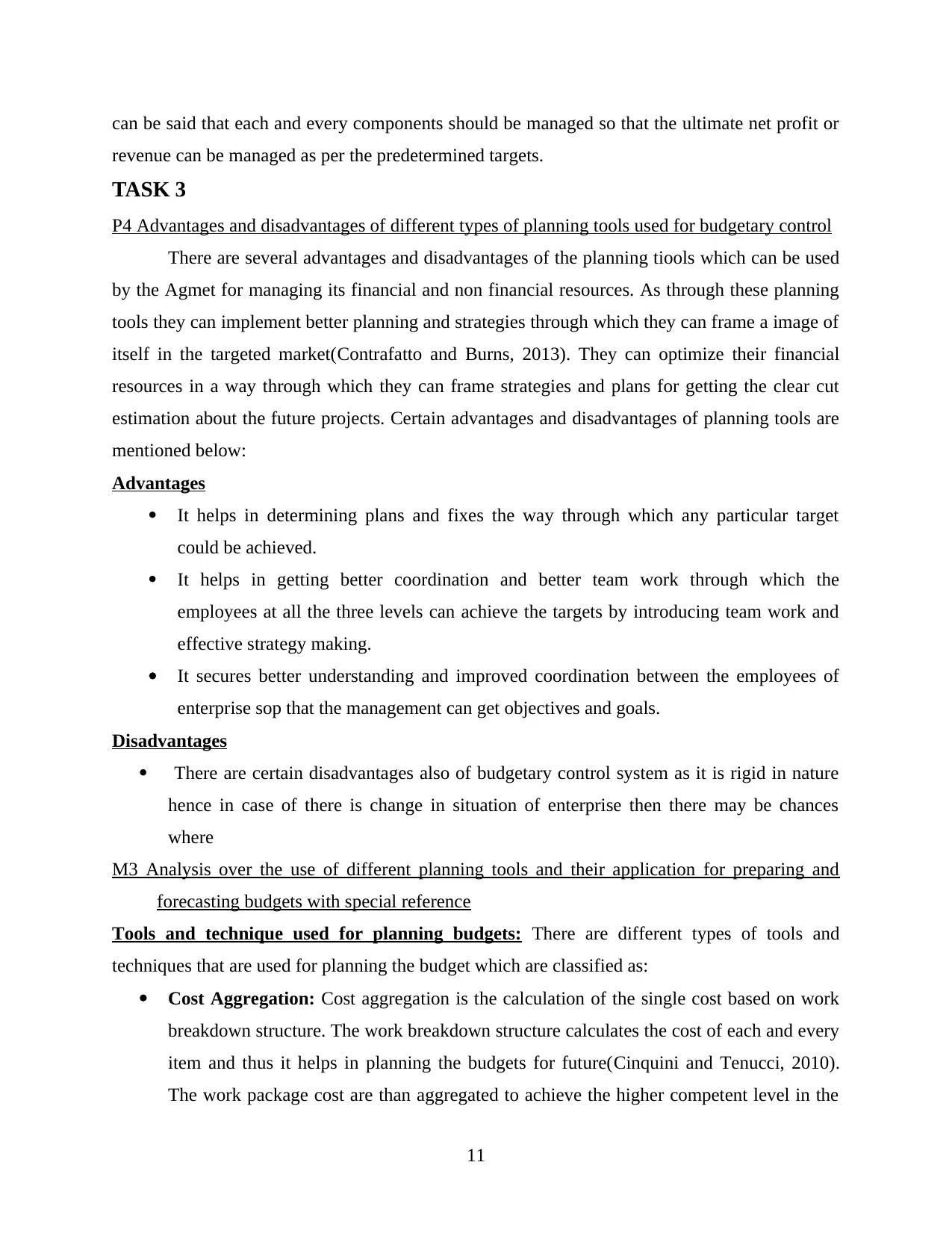
can be said that each and every components should be managed so that the ultimate net profit or
revenue can be managed as per the predetermined targets.
TASK 3
P4 Advantages and disadvantages of different types of planning tools used for budgetary control
There are several advantages and disadvantages of the planning tiools which can be used
by the Agmet for managing its financial and non financial resources. As through these planning
tools they can implement better planning and strategies through which they can frame a image of
itself in the targeted market(Contrafatto and Burns, 2013). They can optimize their financial
resources in a way through which they can frame strategies and plans for getting the clear cut
estimation about the future projects. Certain advantages and disadvantages of planning tools are
mentioned below:
Advantages
It helps in determining plans and fixes the way through which any particular target
could be achieved.
It helps in getting better coordination and better team work through which the
employees at all the three levels can achieve the targets by introducing team work and
effective strategy making.
It secures better understanding and improved coordination between the employees of
enterprise sop that the management can get objectives and goals.
Disadvantages
There are certain disadvantages also of budgetary control system as it is rigid in nature
hence in case of there is change in situation of enterprise then there may be chances
where
M3 Analysis over the use of different planning tools and their application for preparing and
forecasting budgets with special reference
Tools and technique used for planning budgets: There are different types of tools and
techniques that are used for planning the budget which are classified as:
Cost Aggregation: Cost aggregation is the calculation of the single cost based on work
breakdown structure. The work breakdown structure calculates the cost of each and every
item and thus it helps in planning the budgets for future(Cinquini and Tenucci, 2010).
The work package cost are than aggregated to achieve the higher competent level in the
11
revenue can be managed as per the predetermined targets.
TASK 3
P4 Advantages and disadvantages of different types of planning tools used for budgetary control
There are several advantages and disadvantages of the planning tiools which can be used
by the Agmet for managing its financial and non financial resources. As through these planning
tools they can implement better planning and strategies through which they can frame a image of
itself in the targeted market(Contrafatto and Burns, 2013). They can optimize their financial
resources in a way through which they can frame strategies and plans for getting the clear cut
estimation about the future projects. Certain advantages and disadvantages of planning tools are
mentioned below:
Advantages
It helps in determining plans and fixes the way through which any particular target
could be achieved.
It helps in getting better coordination and better team work through which the
employees at all the three levels can achieve the targets by introducing team work and
effective strategy making.
It secures better understanding and improved coordination between the employees of
enterprise sop that the management can get objectives and goals.
Disadvantages
There are certain disadvantages also of budgetary control system as it is rigid in nature
hence in case of there is change in situation of enterprise then there may be chances
where
M3 Analysis over the use of different planning tools and their application for preparing and
forecasting budgets with special reference
Tools and technique used for planning budgets: There are different types of tools and
techniques that are used for planning the budget which are classified as:
Cost Aggregation: Cost aggregation is the calculation of the single cost based on work
breakdown structure. The work breakdown structure calculates the cost of each and every
item and thus it helps in planning the budgets for future(Cinquini and Tenucci, 2010).
The work package cost are than aggregated to achieve the higher competent level in the
11
Paraphrase This Document
Need a fresh take? Get an instant paraphrase of this document with our AI Paraphraser
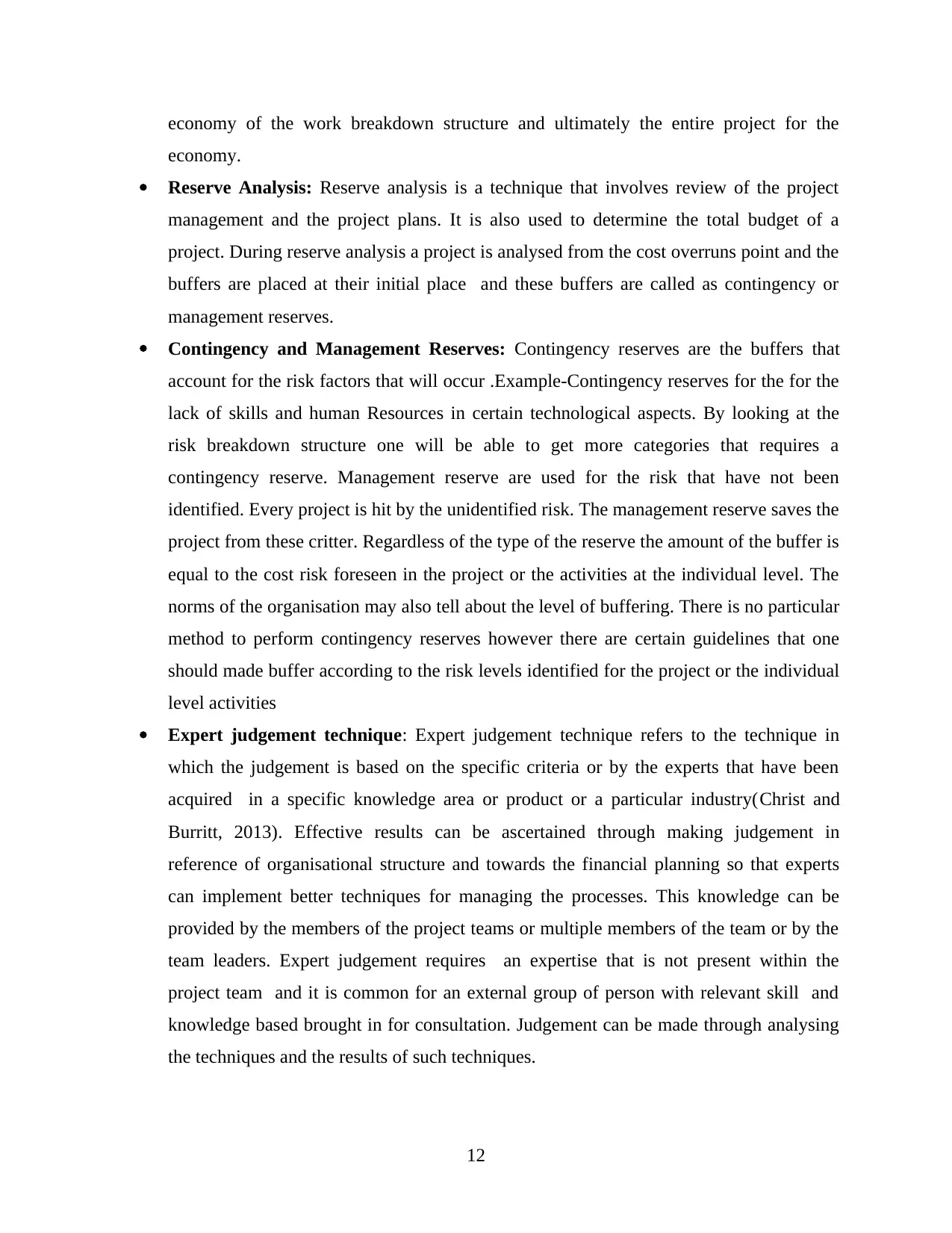
economy of the work breakdown structure and ultimately the entire project for the
economy.
Reserve Analysis: Reserve analysis is a technique that involves review of the project
management and the project plans. It is also used to determine the total budget of a
project. During reserve analysis a project is analysed from the cost overruns point and the
buffers are placed at their initial place and these buffers are called as contingency or
management reserves.
Contingency and Management Reserves: Contingency reserves are the buffers that
account for the risk factors that will occur .Example-Contingency reserves for the for the
lack of skills and human Resources in certain technological aspects. By looking at the
risk breakdown structure one will be able to get more categories that requires a
contingency reserve. Management reserve are used for the risk that have not been
identified. Every project is hit by the unidentified risk. The management reserve saves the
project from these critter. Regardless of the type of the reserve the amount of the buffer is
equal to the cost risk foreseen in the project or the activities at the individual level. The
norms of the organisation may also tell about the level of buffering. There is no particular
method to perform contingency reserves however there are certain guidelines that one
should made buffer according to the risk levels identified for the project or the individual
level activities
Expert judgement technique: Expert judgement technique refers to the technique in
which the judgement is based on the specific criteria or by the experts that have been
acquired in a specific knowledge area or product or a particular industry(Christ and
Burritt, 2013). Effective results can be ascertained through making judgement in
reference of organisational structure and towards the financial planning so that experts
can implement better techniques for managing the processes. This knowledge can be
provided by the members of the project teams or multiple members of the team or by the
team leaders. Expert judgement requires an expertise that is not present within the
project team and it is common for an external group of person with relevant skill and
knowledge based brought in for consultation. Judgement can be made through analysing
the techniques and the results of such techniques.
12
economy.
Reserve Analysis: Reserve analysis is a technique that involves review of the project
management and the project plans. It is also used to determine the total budget of a
project. During reserve analysis a project is analysed from the cost overruns point and the
buffers are placed at their initial place and these buffers are called as contingency or
management reserves.
Contingency and Management Reserves: Contingency reserves are the buffers that
account for the risk factors that will occur .Example-Contingency reserves for the for the
lack of skills and human Resources in certain technological aspects. By looking at the
risk breakdown structure one will be able to get more categories that requires a
contingency reserve. Management reserve are used for the risk that have not been
identified. Every project is hit by the unidentified risk. The management reserve saves the
project from these critter. Regardless of the type of the reserve the amount of the buffer is
equal to the cost risk foreseen in the project or the activities at the individual level. The
norms of the organisation may also tell about the level of buffering. There is no particular
method to perform contingency reserves however there are certain guidelines that one
should made buffer according to the risk levels identified for the project or the individual
level activities
Expert judgement technique: Expert judgement technique refers to the technique in
which the judgement is based on the specific criteria or by the experts that have been
acquired in a specific knowledge area or product or a particular industry(Christ and
Burritt, 2013). Effective results can be ascertained through making judgement in
reference of organisational structure and towards the financial planning so that experts
can implement better techniques for managing the processes. This knowledge can be
provided by the members of the project teams or multiple members of the team or by the
team leaders. Expert judgement requires an expertise that is not present within the
project team and it is common for an external group of person with relevant skill and
knowledge based brought in for consultation. Judgement can be made through analysing
the techniques and the results of such techniques.
12
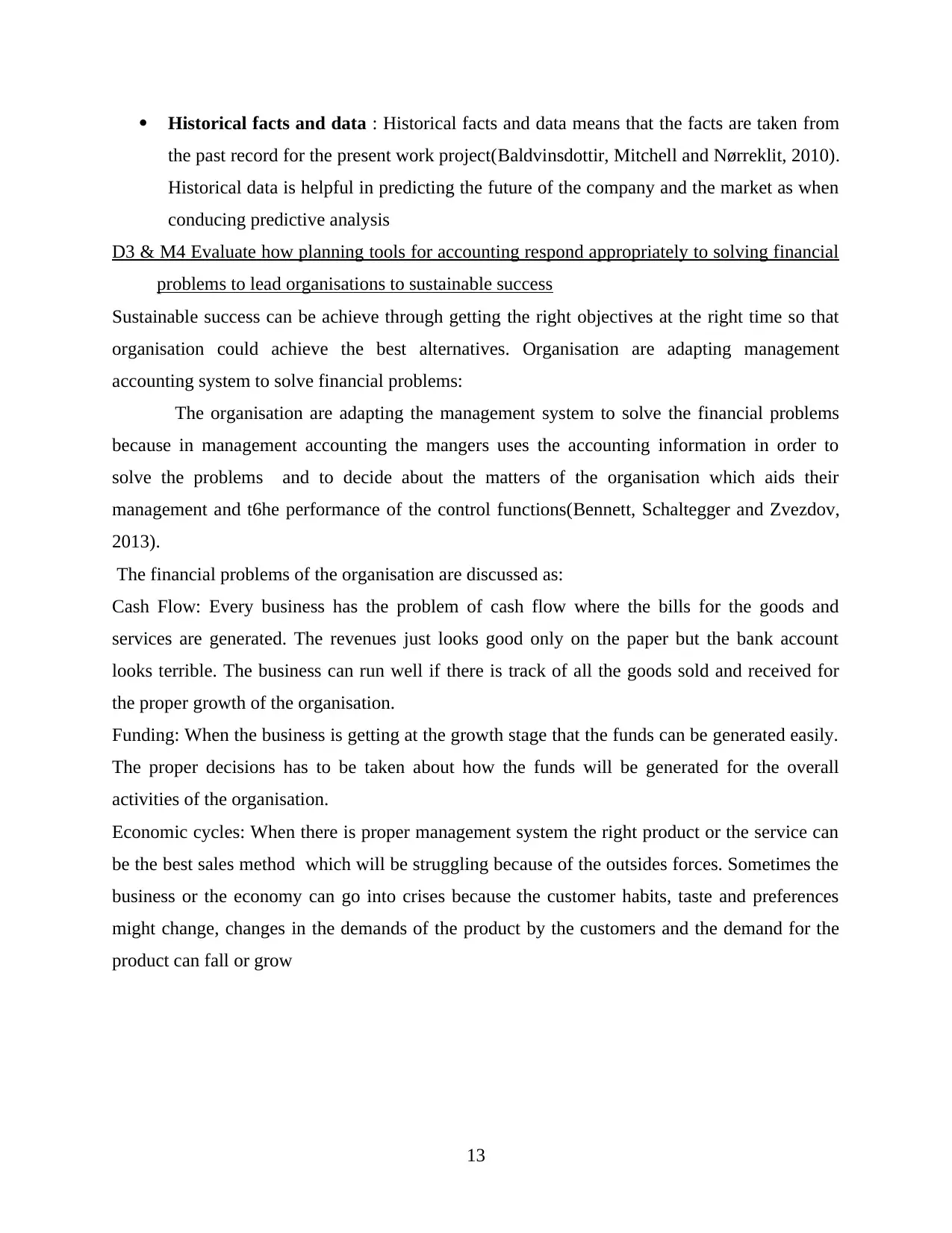
Historical facts and data : Historical facts and data means that the facts are taken from
the past record for the present work project(Baldvinsdottir, Mitchell and Nørreklit, 2010).
Historical data is helpful in predicting the future of the company and the market as when
conducing predictive analysis
D3 & M4 Evaluate how planning tools for accounting respond appropriately to solving financial
problems to lead organisations to sustainable success
Sustainable success can be achieve through getting the right objectives at the right time so that
organisation could achieve the best alternatives. Organisation are adapting management
accounting system to solve financial problems:
The organisation are adapting the management system to solve the financial problems
because in management accounting the mangers uses the accounting information in order to
solve the problems and to decide about the matters of the organisation which aids their
management and t6he performance of the control functions(Bennett, Schaltegger and Zvezdov,
2013).
The financial problems of the organisation are discussed as:
Cash Flow: Every business has the problem of cash flow where the bills for the goods and
services are generated. The revenues just looks good only on the paper but the bank account
looks terrible. The business can run well if there is track of all the goods sold and received for
the proper growth of the organisation.
Funding: When the business is getting at the growth stage that the funds can be generated easily.
The proper decisions has to be taken about how the funds will be generated for the overall
activities of the organisation.
Economic cycles: When there is proper management system the right product or the service can
be the best sales method which will be struggling because of the outsides forces. Sometimes the
business or the economy can go into crises because the customer habits, taste and preferences
might change, changes in the demands of the product by the customers and the demand for the
product can fall or grow
13
the past record for the present work project(Baldvinsdottir, Mitchell and Nørreklit, 2010).
Historical data is helpful in predicting the future of the company and the market as when
conducing predictive analysis
D3 & M4 Evaluate how planning tools for accounting respond appropriately to solving financial
problems to lead organisations to sustainable success
Sustainable success can be achieve through getting the right objectives at the right time so that
organisation could achieve the best alternatives. Organisation are adapting management
accounting system to solve financial problems:
The organisation are adapting the management system to solve the financial problems
because in management accounting the mangers uses the accounting information in order to
solve the problems and to decide about the matters of the organisation which aids their
management and t6he performance of the control functions(Bennett, Schaltegger and Zvezdov,
2013).
The financial problems of the organisation are discussed as:
Cash Flow: Every business has the problem of cash flow where the bills for the goods and
services are generated. The revenues just looks good only on the paper but the bank account
looks terrible. The business can run well if there is track of all the goods sold and received for
the proper growth of the organisation.
Funding: When the business is getting at the growth stage that the funds can be generated easily.
The proper decisions has to be taken about how the funds will be generated for the overall
activities of the organisation.
Economic cycles: When there is proper management system the right product or the service can
be the best sales method which will be struggling because of the outsides forces. Sometimes the
business or the economy can go into crises because the customer habits, taste and preferences
might change, changes in the demands of the product by the customers and the demand for the
product can fall or grow
13
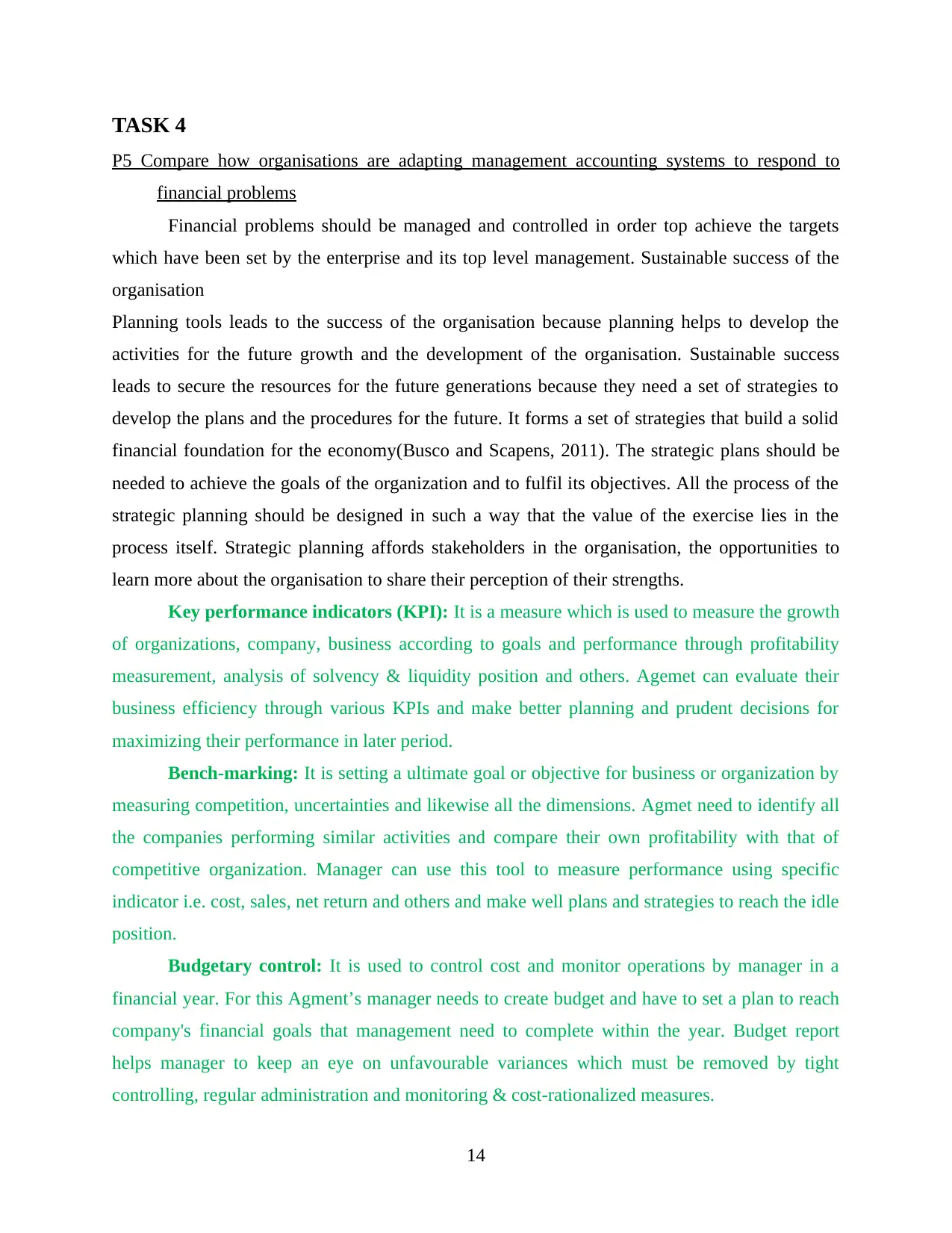
TASK 4
P5 Compare how organisations are adapting management accounting systems to respond to
financial problems
Financial problems should be managed and controlled in order top achieve the targets
which have been set by the enterprise and its top level management. Sustainable success of the
organisation
Planning tools leads to the success of the organisation because planning helps to develop the
activities for the future growth and the development of the organisation. Sustainable success
leads to secure the resources for the future generations because they need a set of strategies to
develop the plans and the procedures for the future. It forms a set of strategies that build a solid
financial foundation for the economy(Busco and Scapens, 2011). The strategic plans should be
needed to achieve the goals of the organization and to fulfil its objectives. All the process of the
strategic planning should be designed in such a way that the value of the exercise lies in the
process itself. Strategic planning affords stakeholders in the organisation, the opportunities to
learn more about the organisation to share their perception of their strengths.
Key performance indicators (KPI): It is a measure which is used to measure the growth
of organizations, company, business according to goals and performance through profitability
measurement, analysis of solvency & liquidity position and others. Agemet can evaluate their
business efficiency through various KPIs and make better planning and prudent decisions for
maximizing their performance in later period.
Bench-marking: It is setting a ultimate goal or objective for business or organization by
measuring competition, uncertainties and likewise all the dimensions. Agmet need to identify all
the companies performing similar activities and compare their own profitability with that of
competitive organization. Manager can use this tool to measure performance using specific
indicator i.e. cost, sales, net return and others and make well plans and strategies to reach the idle
position.
Budgetary control: It is used to control cost and monitor operations by manager in a
financial year. For this Agment’s manager needs to create budget and have to set a plan to reach
company's financial goals that management need to complete within the year. Budget report
helps manager to keep an eye on unfavourable variances which must be removed by tight
controlling, regular administration and monitoring & cost-rationalized measures.
14
P5 Compare how organisations are adapting management accounting systems to respond to
financial problems
Financial problems should be managed and controlled in order top achieve the targets
which have been set by the enterprise and its top level management. Sustainable success of the
organisation
Planning tools leads to the success of the organisation because planning helps to develop the
activities for the future growth and the development of the organisation. Sustainable success
leads to secure the resources for the future generations because they need a set of strategies to
develop the plans and the procedures for the future. It forms a set of strategies that build a solid
financial foundation for the economy(Busco and Scapens, 2011). The strategic plans should be
needed to achieve the goals of the organization and to fulfil its objectives. All the process of the
strategic planning should be designed in such a way that the value of the exercise lies in the
process itself. Strategic planning affords stakeholders in the organisation, the opportunities to
learn more about the organisation to share their perception of their strengths.
Key performance indicators (KPI): It is a measure which is used to measure the growth
of organizations, company, business according to goals and performance through profitability
measurement, analysis of solvency & liquidity position and others. Agemet can evaluate their
business efficiency through various KPIs and make better planning and prudent decisions for
maximizing their performance in later period.
Bench-marking: It is setting a ultimate goal or objective for business or organization by
measuring competition, uncertainties and likewise all the dimensions. Agmet need to identify all
the companies performing similar activities and compare their own profitability with that of
competitive organization. Manager can use this tool to measure performance using specific
indicator i.e. cost, sales, net return and others and make well plans and strategies to reach the idle
position.
Budgetary control: It is used to control cost and monitor operations by manager in a
financial year. For this Agment’s manager needs to create budget and have to set a plan to reach
company's financial goals that management need to complete within the year. Budget report
helps manager to keep an eye on unfavourable variances which must be removed by tight
controlling, regular administration and monitoring & cost-rationalized measures.
14
Secure Best Marks with AI Grader
Need help grading? Try our AI Grader for instant feedback on your assignments.
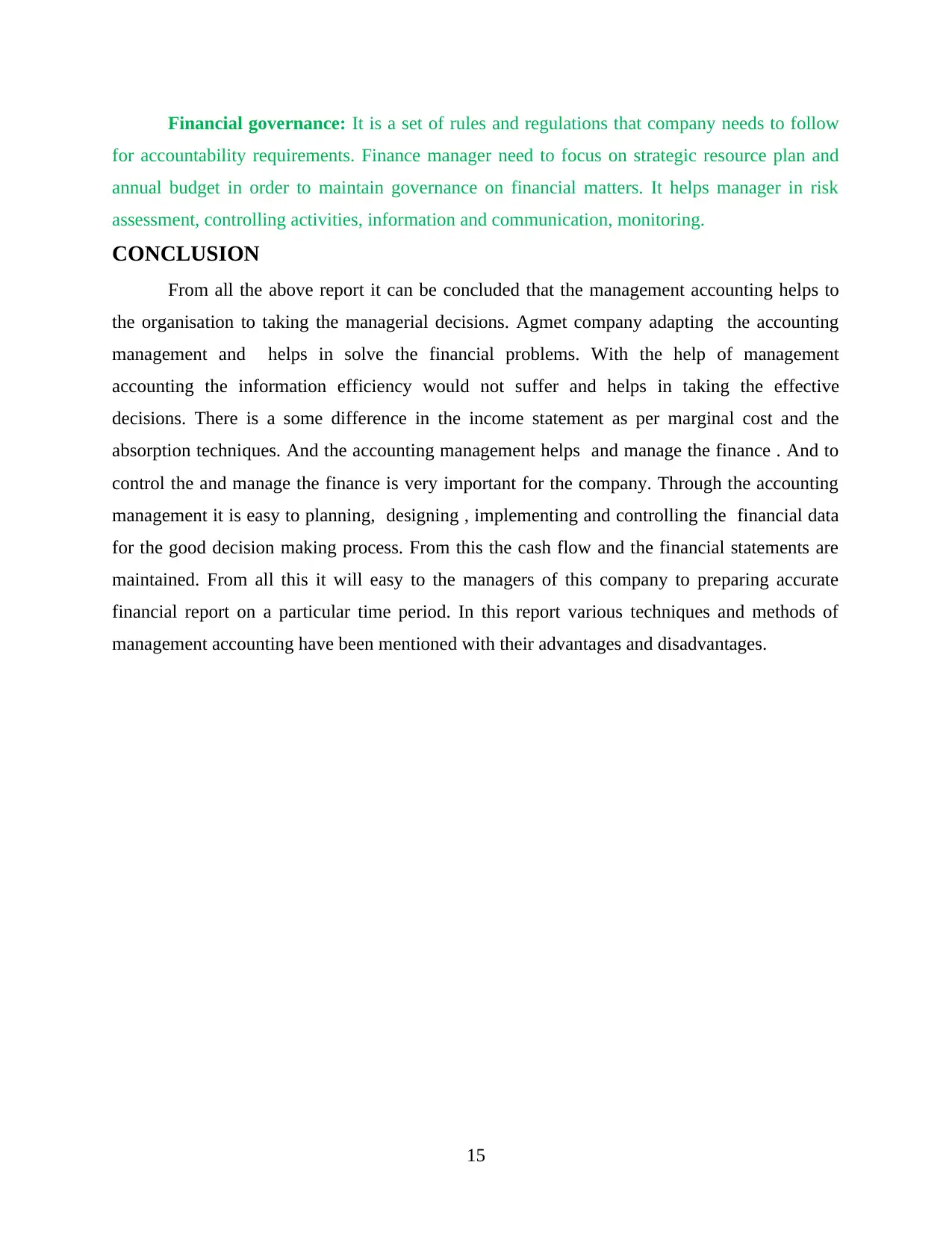
Financial governance: It is a set of rules and regulations that company needs to follow
for accountability requirements. Finance manager need to focus on strategic resource plan and
annual budget in order to maintain governance on financial matters. It helps manager in risk
assessment, controlling activities, information and communication, monitoring.
CONCLUSION
From all the above report it can be concluded that the management accounting helps to
the organisation to taking the managerial decisions. Agmet company adapting the accounting
management and helps in solve the financial problems. With the help of management
accounting the information efficiency would not suffer and helps in taking the effective
decisions. There is a some difference in the income statement as per marginal cost and the
absorption techniques. And the accounting management helps and manage the finance . And to
control the and manage the finance is very important for the company. Through the accounting
management it is easy to planning, designing , implementing and controlling the financial data
for the good decision making process. From this the cash flow and the financial statements are
maintained. From all this it will easy to the managers of this company to preparing accurate
financial report on a particular time period. In this report various techniques and methods of
management accounting have been mentioned with their advantages and disadvantages.
15
for accountability requirements. Finance manager need to focus on strategic resource plan and
annual budget in order to maintain governance on financial matters. It helps manager in risk
assessment, controlling activities, information and communication, monitoring.
CONCLUSION
From all the above report it can be concluded that the management accounting helps to
the organisation to taking the managerial decisions. Agmet company adapting the accounting
management and helps in solve the financial problems. With the help of management
accounting the information efficiency would not suffer and helps in taking the effective
decisions. There is a some difference in the income statement as per marginal cost and the
absorption techniques. And the accounting management helps and manage the finance . And to
control the and manage the finance is very important for the company. Through the accounting
management it is easy to planning, designing , implementing and controlling the financial data
for the good decision making process. From this the cash flow and the financial statements are
maintained. From all this it will easy to the managers of this company to preparing accurate
financial report on a particular time period. In this report various techniques and methods of
management accounting have been mentioned with their advantages and disadvantages.
15
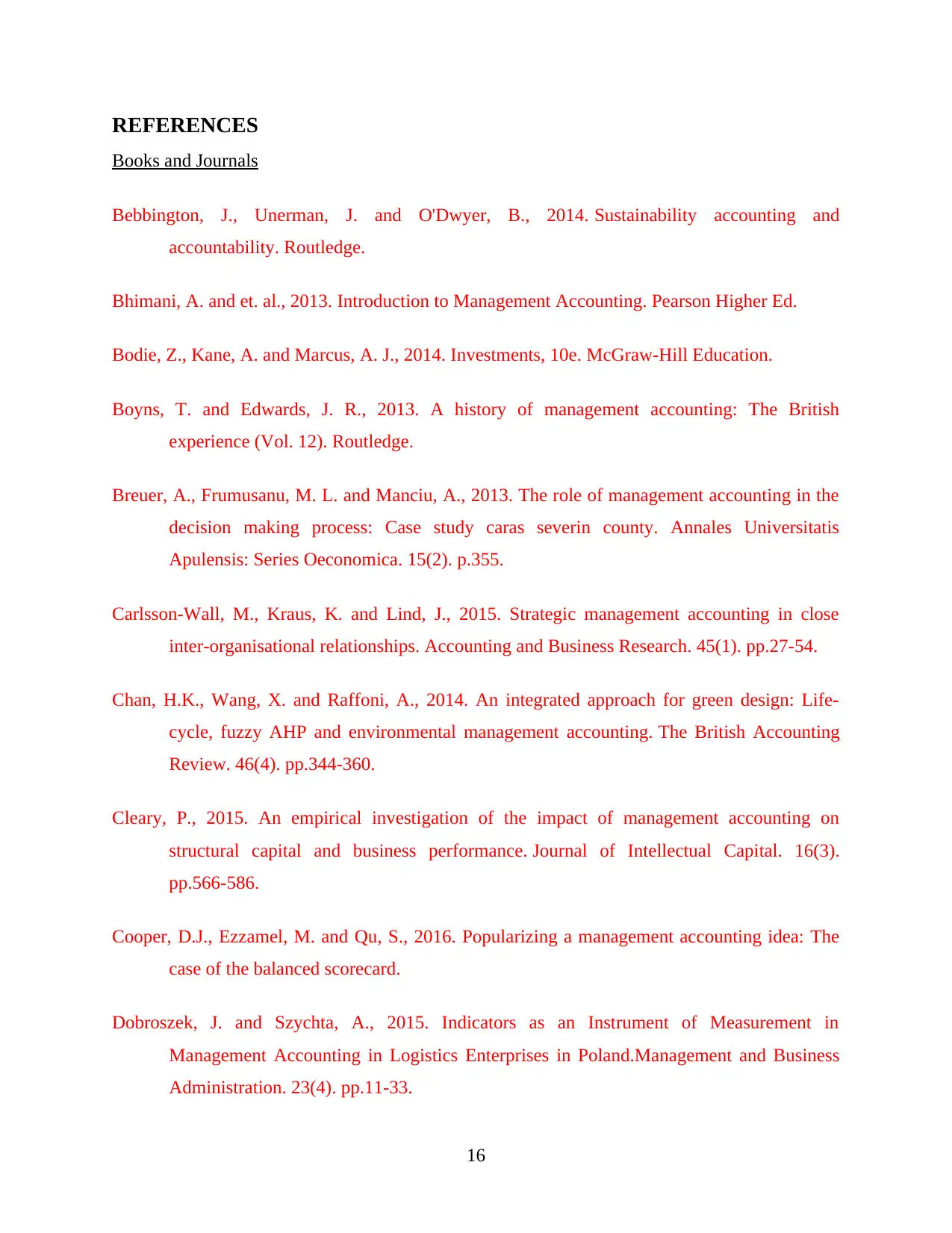
REFERENCES
Books and Journals
Bebbington, J., Unerman, J. and O'Dwyer, B., 2014. Sustainability accounting and
accountability. Routledge.
Bhimani, A. and et. al., 2013. Introduction to Management Accounting. Pearson Higher Ed.
Bodie, Z., Kane, A. and Marcus, A. J., 2014. Investments, 10e. McGraw-Hill Education.
Boyns, T. and Edwards, J. R., 2013. A history of management accounting: The British
experience (Vol. 12). Routledge.
Breuer, A., Frumusanu, M. L. and Manciu, A., 2013. The role of management accounting in the
decision making process: Case study caras severin county. Annales Universitatis
Apulensis: Series Oeconomica. 15(2). p.355.
Carlsson-Wall, M., Kraus, K. and Lind, J., 2015. Strategic management accounting in close
inter-organisational relationships. Accounting and Business Research. 45(1). pp.27-54.
Chan, H.K., Wang, X. and Raffoni, A., 2014. An integrated approach for green design: Life-
cycle, fuzzy AHP and environmental management accounting. The British Accounting
Review. 46(4). pp.344-360.
Cleary, P., 2015. An empirical investigation of the impact of management accounting on
structural capital and business performance. Journal of Intellectual Capital. 16(3).
pp.566-586.
Cooper, D.J., Ezzamel, M. and Qu, S., 2016. Popularizing a management accounting idea: The
case of the balanced scorecard.
Dobroszek, J. and Szychta, A., 2015. Indicators as an Instrument of Measurement in
Management Accounting in Logistics Enterprises in Poland.Management and Business
Administration. 23(4). pp.11-33.
16
Books and Journals
Bebbington, J., Unerman, J. and O'Dwyer, B., 2014. Sustainability accounting and
accountability. Routledge.
Bhimani, A. and et. al., 2013. Introduction to Management Accounting. Pearson Higher Ed.
Bodie, Z., Kane, A. and Marcus, A. J., 2014. Investments, 10e. McGraw-Hill Education.
Boyns, T. and Edwards, J. R., 2013. A history of management accounting: The British
experience (Vol. 12). Routledge.
Breuer, A., Frumusanu, M. L. and Manciu, A., 2013. The role of management accounting in the
decision making process: Case study caras severin county. Annales Universitatis
Apulensis: Series Oeconomica. 15(2). p.355.
Carlsson-Wall, M., Kraus, K. and Lind, J., 2015. Strategic management accounting in close
inter-organisational relationships. Accounting and Business Research. 45(1). pp.27-54.
Chan, H.K., Wang, X. and Raffoni, A., 2014. An integrated approach for green design: Life-
cycle, fuzzy AHP and environmental management accounting. The British Accounting
Review. 46(4). pp.344-360.
Cleary, P., 2015. An empirical investigation of the impact of management accounting on
structural capital and business performance. Journal of Intellectual Capital. 16(3).
pp.566-586.
Cooper, D.J., Ezzamel, M. and Qu, S., 2016. Popularizing a management accounting idea: The
case of the balanced scorecard.
Dobroszek, J. and Szychta, A., 2015. Indicators as an Instrument of Measurement in
Management Accounting in Logistics Enterprises in Poland.Management and Business
Administration. 23(4). pp.11-33.
16
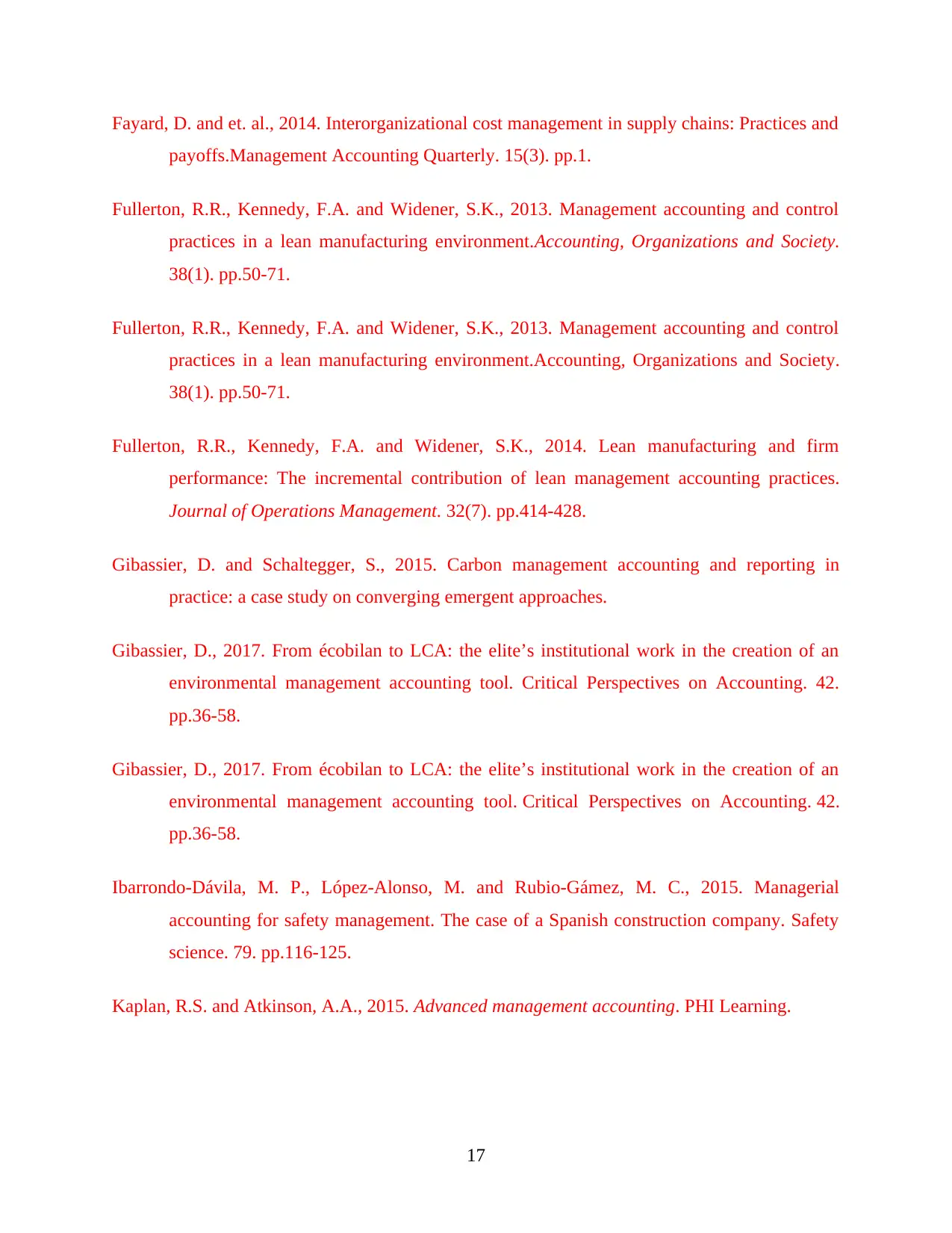
Fayard, D. and et. al., 2014. Interorganizational cost management in supply chains: Practices and
payoffs.Management Accounting Quarterly. 15(3). pp.1.
Fullerton, R.R., Kennedy, F.A. and Widener, S.K., 2013. Management accounting and control
practices in a lean manufacturing environment.Accounting, Organizations and Society.
38(1). pp.50-71.
Fullerton, R.R., Kennedy, F.A. and Widener, S.K., 2013. Management accounting and control
practices in a lean manufacturing environment.Accounting, Organizations and Society.
38(1). pp.50-71.
Fullerton, R.R., Kennedy, F.A. and Widener, S.K., 2014. Lean manufacturing and firm
performance: The incremental contribution of lean management accounting practices.
Journal of Operations Management. 32(7). pp.414-428.
Gibassier, D. and Schaltegger, S., 2015. Carbon management accounting and reporting in
practice: a case study on converging emergent approaches.
Gibassier, D., 2017. From écobilan to LCA: the elite’s institutional work in the creation of an
environmental management accounting tool. Critical Perspectives on Accounting. 42.
pp.36-58.
Gibassier, D., 2017. From écobilan to LCA: the elite’s institutional work in the creation of an
environmental management accounting tool. Critical Perspectives on Accounting. 42.
pp.36-58.
Ibarrondo-Dávila, M. P., López-Alonso, M. and Rubio-Gámez, M. C., 2015. Managerial
accounting for safety management. The case of a Spanish construction company. Safety
science. 79. pp.116-125.
Kaplan, R.S. and Atkinson, A.A., 2015. Advanced management accounting. PHI Learning.
17
payoffs.Management Accounting Quarterly. 15(3). pp.1.
Fullerton, R.R., Kennedy, F.A. and Widener, S.K., 2013. Management accounting and control
practices in a lean manufacturing environment.Accounting, Organizations and Society.
38(1). pp.50-71.
Fullerton, R.R., Kennedy, F.A. and Widener, S.K., 2013. Management accounting and control
practices in a lean manufacturing environment.Accounting, Organizations and Society.
38(1). pp.50-71.
Fullerton, R.R., Kennedy, F.A. and Widener, S.K., 2014. Lean manufacturing and firm
performance: The incremental contribution of lean management accounting practices.
Journal of Operations Management. 32(7). pp.414-428.
Gibassier, D. and Schaltegger, S., 2015. Carbon management accounting and reporting in
practice: a case study on converging emergent approaches.
Gibassier, D., 2017. From écobilan to LCA: the elite’s institutional work in the creation of an
environmental management accounting tool. Critical Perspectives on Accounting. 42.
pp.36-58.
Gibassier, D., 2017. From écobilan to LCA: the elite’s institutional work in the creation of an
environmental management accounting tool. Critical Perspectives on Accounting. 42.
pp.36-58.
Ibarrondo-Dávila, M. P., López-Alonso, M. and Rubio-Gámez, M. C., 2015. Managerial
accounting for safety management. The case of a Spanish construction company. Safety
science. 79. pp.116-125.
Kaplan, R.S. and Atkinson, A.A., 2015. Advanced management accounting. PHI Learning.
17
Paraphrase This Document
Need a fresh take? Get an instant paraphrase of this document with our AI Paraphraser
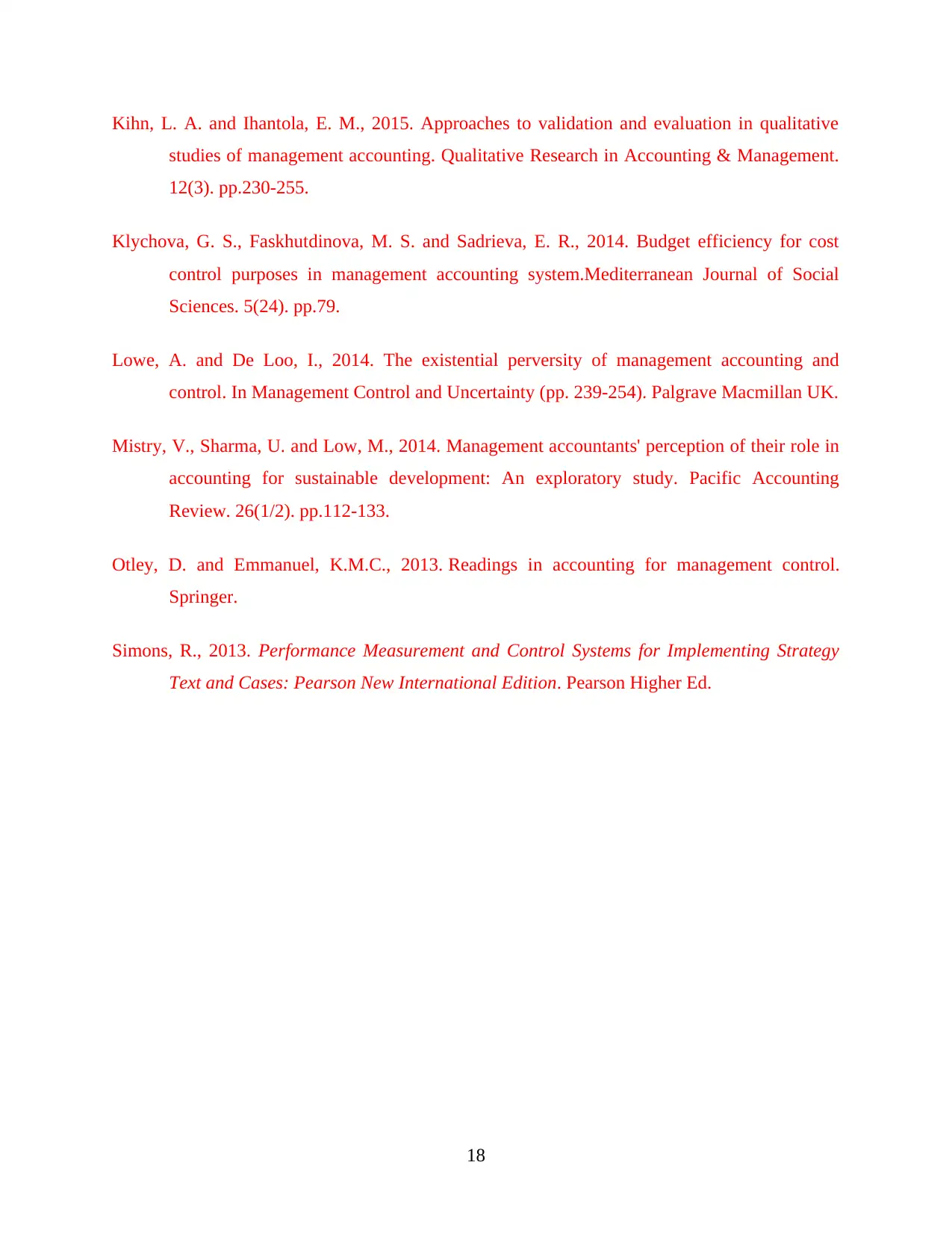
Kihn, L. A. and Ihantola, E. M., 2015. Approaches to validation and evaluation in qualitative
studies of management accounting. Qualitative Research in Accounting & Management.
12(3). pp.230-255.
Klychova, G. S., Faskhutdinova, М. S. and Sadrieva, E. R., 2014. Budget efficiency for cost
control purposes in management accounting system.Mediterranean Journal of Social
Sciences. 5(24). pp.79.
Lowe, A. and De Loo, I., 2014. The existential perversity of management accounting and
control. In Management Control and Uncertainty (pp. 239-254). Palgrave Macmillan UK.
Mistry, V., Sharma, U. and Low, M., 2014. Management accountants' perception of their role in
accounting for sustainable development: An exploratory study. Pacific Accounting
Review. 26(1/2). pp.112-133.
Otley, D. and Emmanuel, K.M.C., 2013. Readings in accounting for management control.
Springer.
Simons, R., 2013. Performance Measurement and Control Systems for Implementing Strategy
Text and Cases: Pearson New International Edition. Pearson Higher Ed.
18
studies of management accounting. Qualitative Research in Accounting & Management.
12(3). pp.230-255.
Klychova, G. S., Faskhutdinova, М. S. and Sadrieva, E. R., 2014. Budget efficiency for cost
control purposes in management accounting system.Mediterranean Journal of Social
Sciences. 5(24). pp.79.
Lowe, A. and De Loo, I., 2014. The existential perversity of management accounting and
control. In Management Control and Uncertainty (pp. 239-254). Palgrave Macmillan UK.
Mistry, V., Sharma, U. and Low, M., 2014. Management accountants' perception of their role in
accounting for sustainable development: An exploratory study. Pacific Accounting
Review. 26(1/2). pp.112-133.
Otley, D. and Emmanuel, K.M.C., 2013. Readings in accounting for management control.
Springer.
Simons, R., 2013. Performance Measurement and Control Systems for Implementing Strategy
Text and Cases: Pearson New International Edition. Pearson Higher Ed.
18
1 out of 20
Related Documents
Your All-in-One AI-Powered Toolkit for Academic Success.
+13062052269
info@desklib.com
Available 24*7 on WhatsApp / Email
![[object Object]](/_next/static/media/star-bottom.7253800d.svg)
Unlock your academic potential
© 2024 | Zucol Services PVT LTD | All rights reserved.





